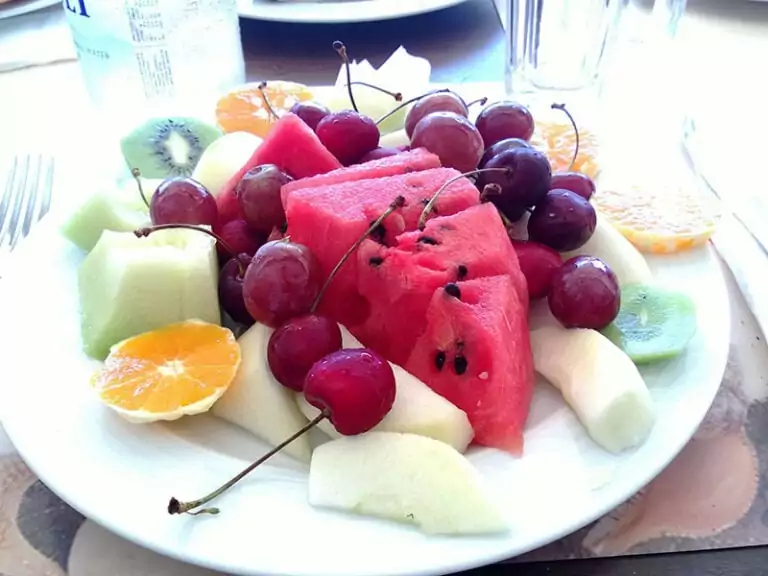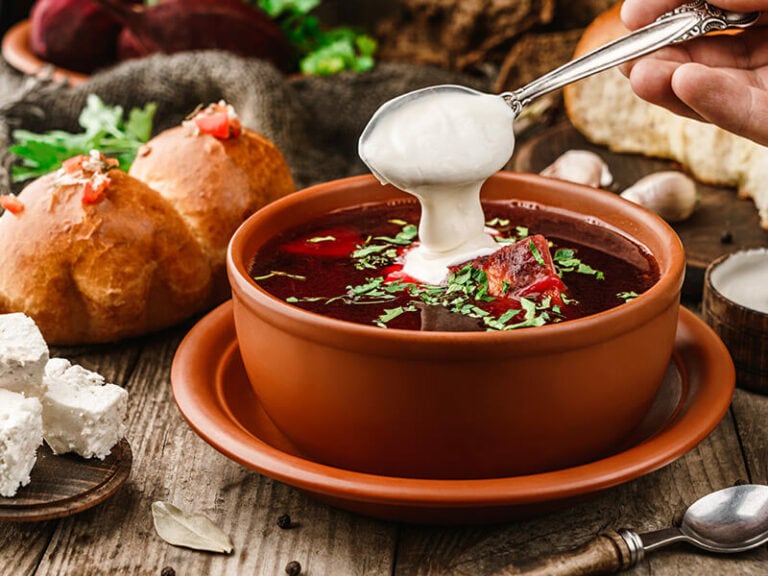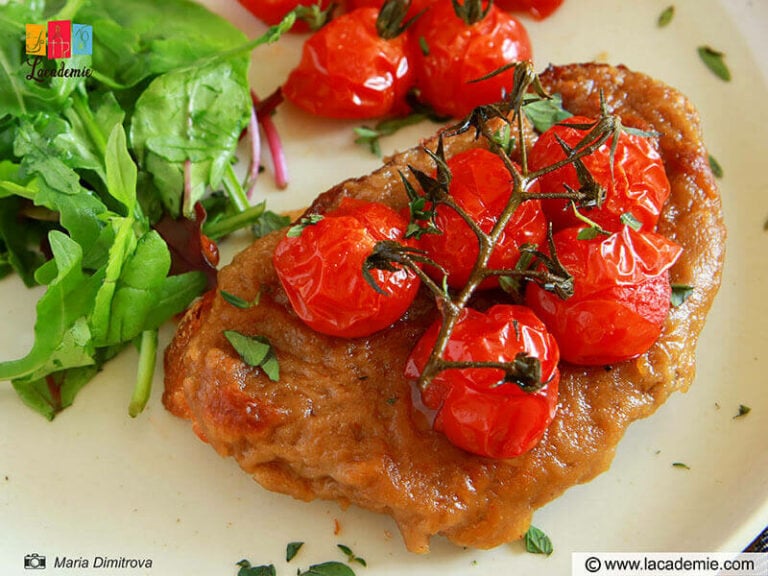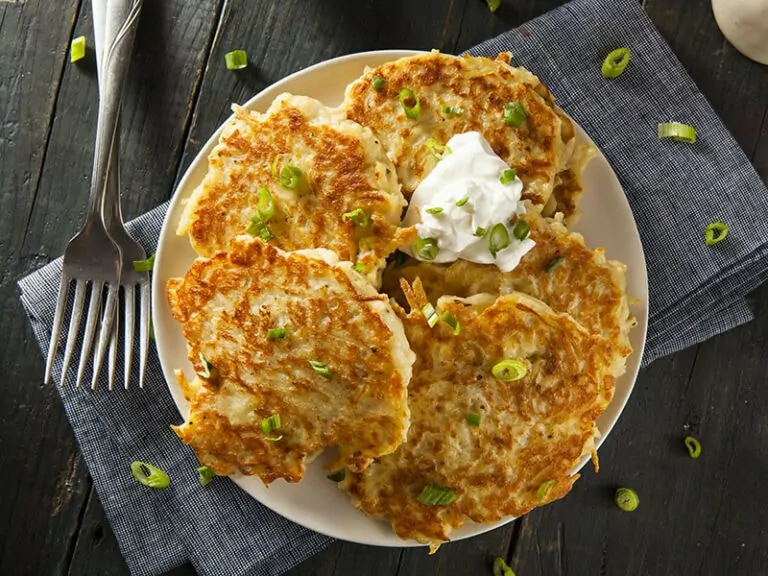There’s a world of traditional Western European dishes waiting for you. By exploring these culinary masterpieces, you’ll learn more about these timeless dishes and why they continue to capture foodies’ hearts around the globe.
Take this opportunity to dive deeper into the rich history of Europe and understand how regional variations contribute to the unique character of each dish. You can also understand time-honored cooking techniques that have been passed down through generations.
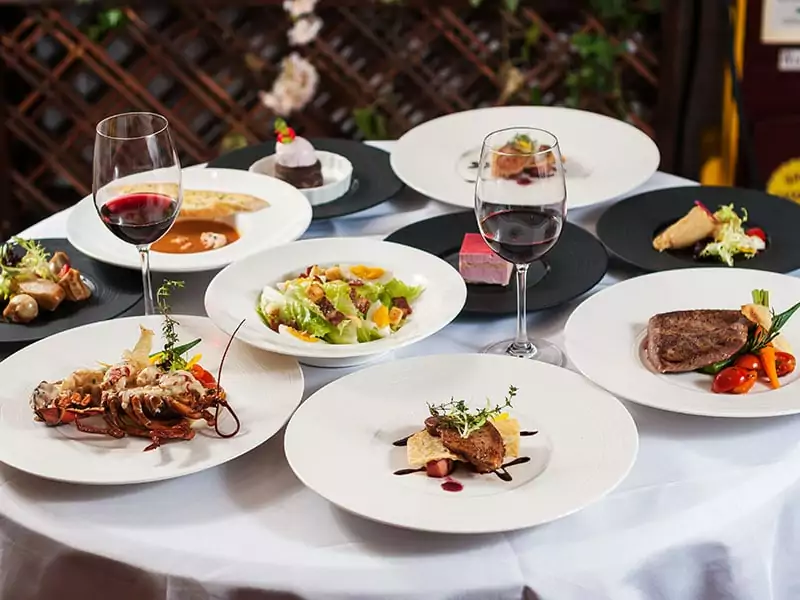
Definition of Western European Cuisine
Western European cuisine refers to the foods, cooking methods, and customs associated with countries in Western Europe. It includes nations such as the United Kingdom, France, Belgium, and the Netherlands, among others.
Western European cuisine is often seen as a pillar of global gastronomy, with dishes as varied as the cultures they come from. This culinary region is also famed for its exceptional cheeses, wines, and beers.
Brief Overview of Culinary History in Western Europe
The earliest influences can be traced back to the Romans, who introduced methods of agriculture, vine cultivation, and the keeping of livestock. Throughout the Middle Ages, religious institutions like monasteries played a crucial role in the development of farming and winemaking.
As European nations began to explore and colonize other parts of the world from the 15th century onward, new ingredients were introduced to Western Europe. Foods such as potatoes, tomatoes, and peppers arrived in Europe from the New World. Asian spices also became more accessible.
France, in particular, began to formalize its culinary arts during the 17th and 18th centuries. Modern restaurant dining emerged then, marking a watershed moment in the history of European cuisine.
In the 19th and 20th centuries, industrialization influenced food preservation and distribution, leading to changes in diet and food availability. Each country in Western Europe continued to develop its distinctive culinary traditions and local dishes.
In recent years, there has been a renewed focus on locally sourced ingredients, traditional cooking methods, and an embrace of lesser-known gastronomies. The evolution of Western European cuisine is still in progress.
France
1. Quiche
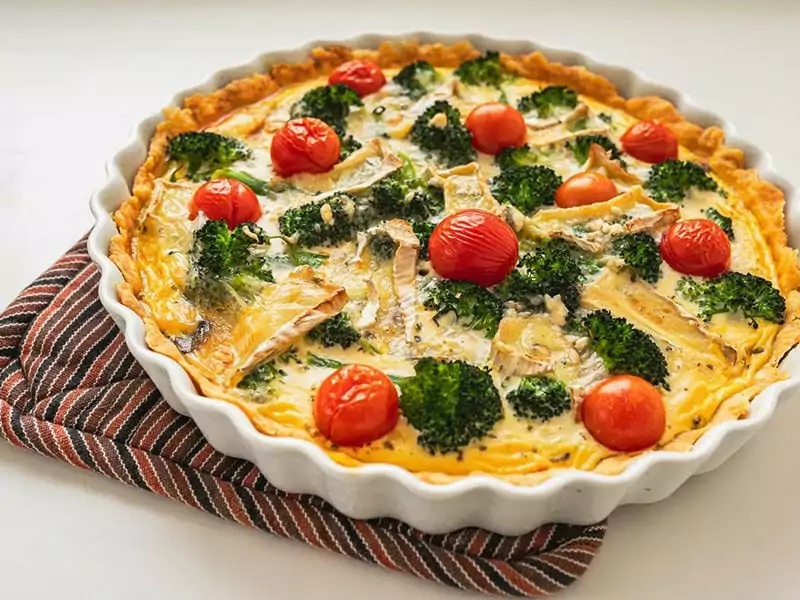
A classic dish in French cuisine since the medieval era, quiche has grown in popularity all over the world, and for good reason! It became a go-to picnic staple in Britain post World War II and eventually turned heads in the US around the 1950s.
Quiche is a baked tart with a pastry crust filled to the brim with a savory custard and additional fillings. This can range from wholesome vegetables like spinach to hearty proteins like meat, cheese, and seafood. You may even stumble upon sweet variants.
One of the most well-known types is Quiche Lorraine, a delicious specialty from Lorraine. The beauty of quiche is its versatility – you can healthify it with low-fat cheese and extra veggies, turning it into a nourishing one-dish meal.
2. Bœuf Bourguignon (Beef Stew In Red Wine)
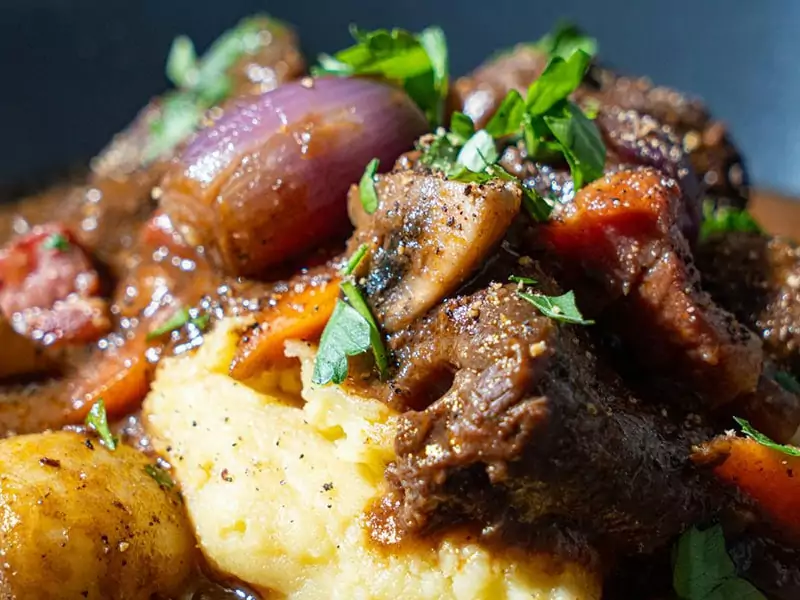
Bœuf Bourguignon is a delicious, centuries-old beef stew born in the Burgundy region of eastern France – an area renowned for its top-notch wines. It consists of beef cubes simmered to perfection with carrots, onions, garlic, and herbs in a bath of beef stock and red wine.
But not just any red wine: you should use red Burgundy wine to create a depth of flavor that makes the beef extraordinarily tender, juicy, and flavorful. For the topping, go for bacon or mushrooms.
This stew has won over French hearts more than snails or frog legs. To savor it in its full glory, pair it with green beans, crusty bread, mashed potatoes, and a glass of, you guessed it, red Burgundy.
3. Quiche Lorraine
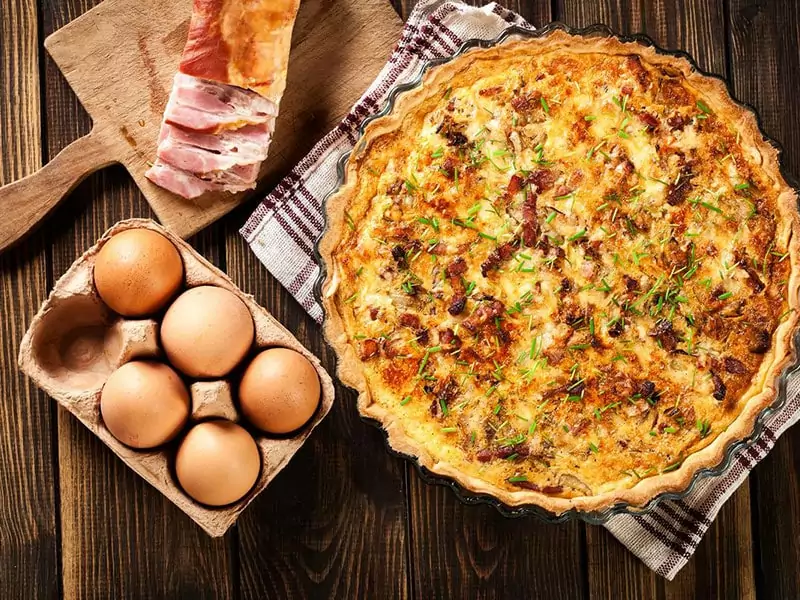
Quiche Lorraine is a flavorful specialty of the Lorraine region in eastern France. From a treat with obscure origins and little fame outside its hometown, it catapulted into popularity in the mid-20th century.
Now, it stands as one of the most popular quiche varieties worldwide. The savory filling, rich with bacon, lardons, ham, cream, and eggs, gives the quiche a mouthwatering allure. Among the main ingredients, it’s the bacon that separates Quiche Lorraine from other quiche types.
Quiche Lorraine is light on vegetables, which may be due to the German influence (the Lorraine region is close to Germany, after all). While many recipes might suggest adding cheese, purists might argue this strays from the authentic version.
4. Bouillabaisse (Provençal Fish Stew)
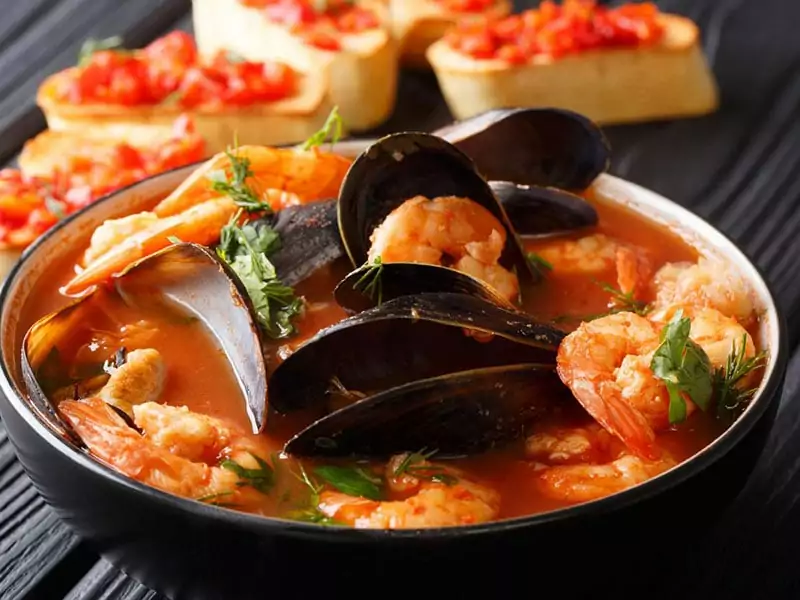
“Bouillabaisse,” easy on the tongue when you say “BOO-ya-bess,” is a Provençal fish stew originating from Marseille. Its flavorful depth owes much to the unique Herbes de Provence spice mix, enhanced with a sprinkle of saffron or a hint of orange zest.
The heart of this dish lies in its choice of fish. Mediterranean specialties like European conger, red rascasse, and sea robin are a must-have, while monkfish, mullet, European hake, and gilt-head bream are optional choices. Besides seafood, leeks, tomatoes, celery, and potatoes join the party too.
Once a humble, cost-effective meal, Bouillabaisse has seen an upgrade in its status. It is now considered a high-end delicacy that might even include premium add-ons like lobster or oysters. For serving, a slice of baguette or garlic bread makes the perfect companion.
5. Beignets (Deep-fried Pastry)
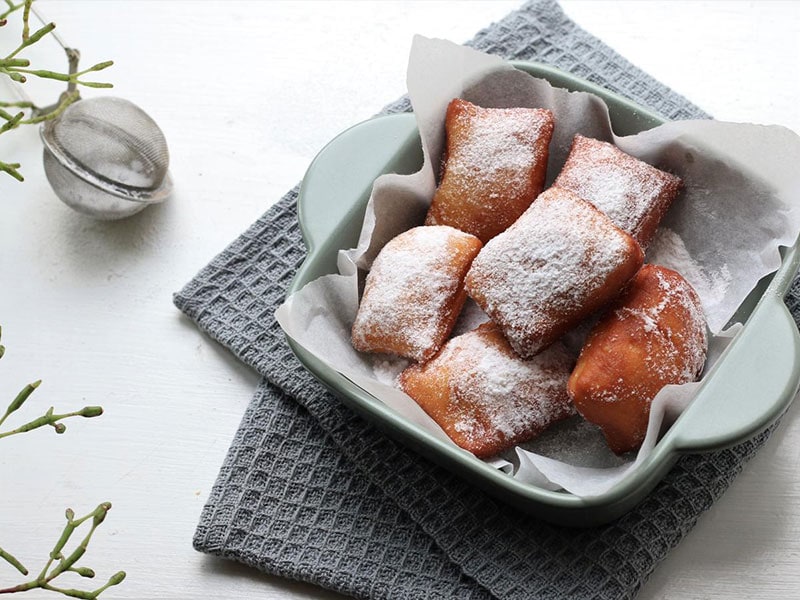
This deep-fried pastry is also known as Beigne in some French-speaking nations. The secret of their tastiness lies in sweetened yeast dough or choux pastry, deep-fried to perfection and then generously dusted with confectioner’s sugar.
They are airy, fluffy treats that share a similar flavor profile to doughnuts. However, beignets stand out due to their higher yeast and lower egg content. In addition, they come in squares, not ring-like shapes like doughnuts.
From sweet to savory, the filling in a beignet can vary, offering a delightful surprise with each bite. Some people even dub them “French doughnuts.”
In Louisiana, they embrace a different style of beignets, creating a popular variant always made from yeast dough and featuring a small hole in the middle. Whether paired with fruit jam, coffee, milk, or ice cream, beignets make an irresistible snack or breakfast choice.
6. Hollandaise Sauce
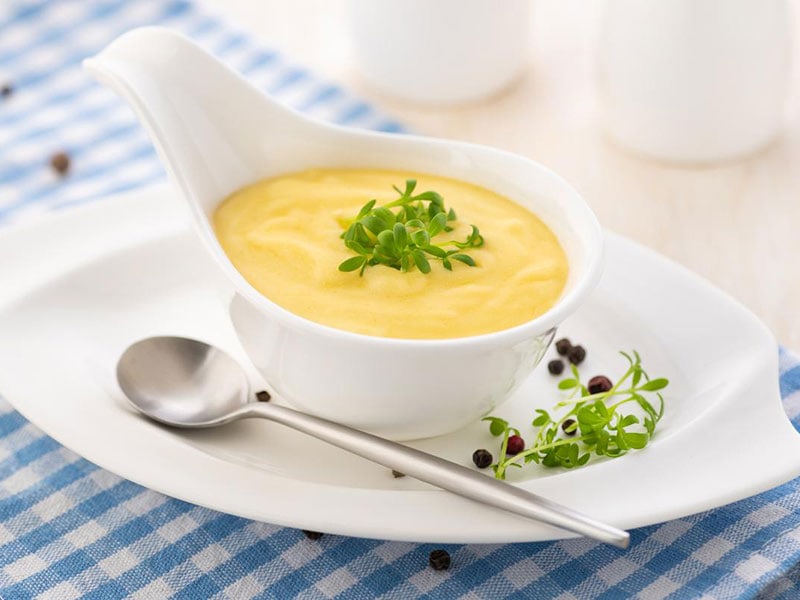
Hollandaise sauce, known as one of the five French mother sauces [1], holds a special place in the culinary world. Despite its French association, it might actually have Dutch roots, giving rise to its alternative name, Dutch sauce.
This dish boasts a luxurious and rich flavor along with a tart taste from tart lemon juice. This exquisite taste is derived from ingredients like egg yolk, lemon juice, salt, melted butter, and spices (like white pepper and cayenne powder).
This splendid sauce isn’t picky about accompaniments. It goes wonderfully with eggs, bread, bacon, seafood, and roasted veggies. But be gentle while preparing it since overcooking the egg yolks or using too-hot butter might steal away its charm.
7. Parfait (Frozen Dessert)
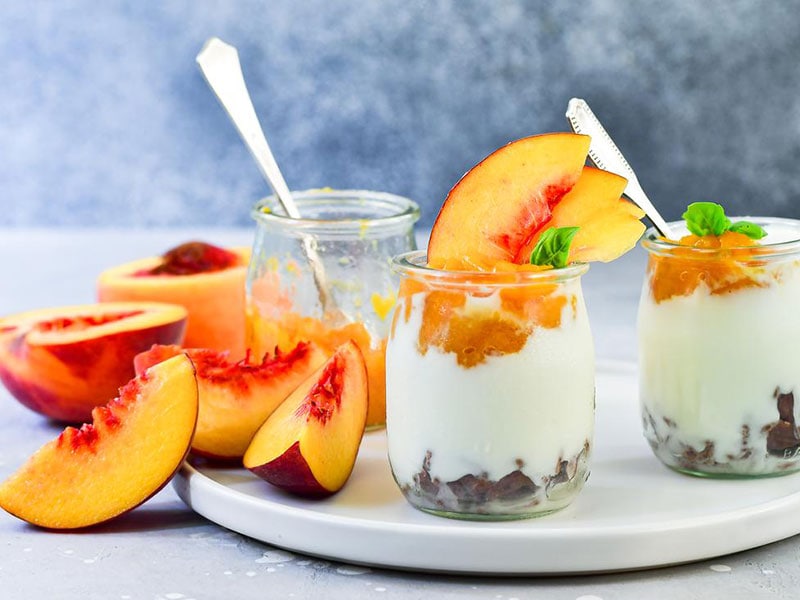
True to its name, which translates to “perfect,” Parfait is a sublime combination of eggs, cream, syrup, and sugar. The making process involves boiling the mixture into a meringue-like puree and then freezing it. The last step is to serve it in slices on a plate.
However, if you’re in America, you’ll find a different take on this delicacy. American parfait swaps traditional French ingredients for layers of yogurts, cream, granola, and nuts. A drizzle of liqueurs and fruit and whipped cream toppings are also necessary. This version is served in a tall glass.
8. Terrine (French Meat Loaf Dish)
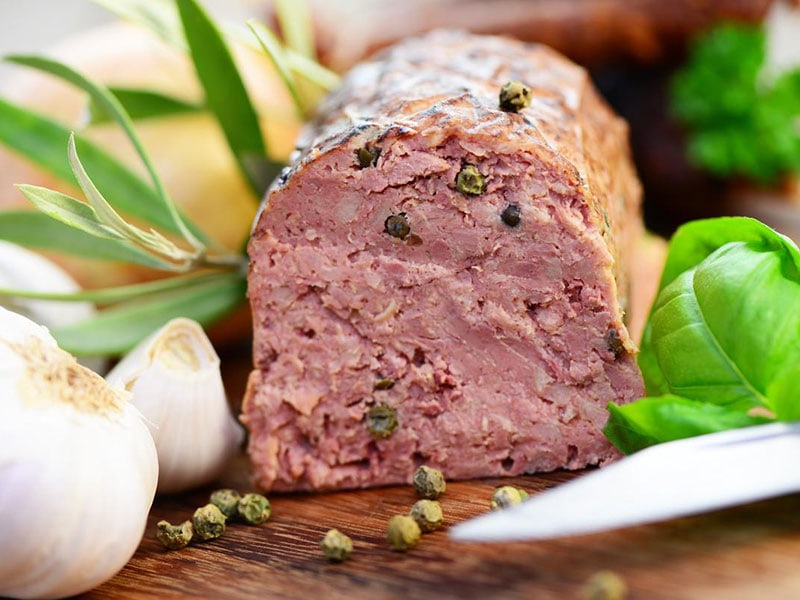
Terrines draw their name from the ceramic or enameled cast iron vessel they are prepared in. This meatloaf-like dish is a melange of finely chopped meat, fat, and spices.
Many kinds of meat can go into a terrine, including lamb, pork, duck, fish, wild game, and extravagant foie gras. Unlike the smooth consistency of liver-based pâtés, terrines celebrate their chunkiness with pride.
Vegetarian terrines also exist, with mushrooms, zucchinis, eggplants, and beets as the core ingredients. Gently cooked in a water bath, the mixture transforms into a dish with a hearty texture and an intense flavor.
To enjoy a terrine, slice it and pair with bread, fruits, vegetables, salads, or pickles. Its charm is best appreciated when served cold or at room temperature, providing a departure from traditional meatloaf.
9. Soufflé (Baked Egg-based Dish)
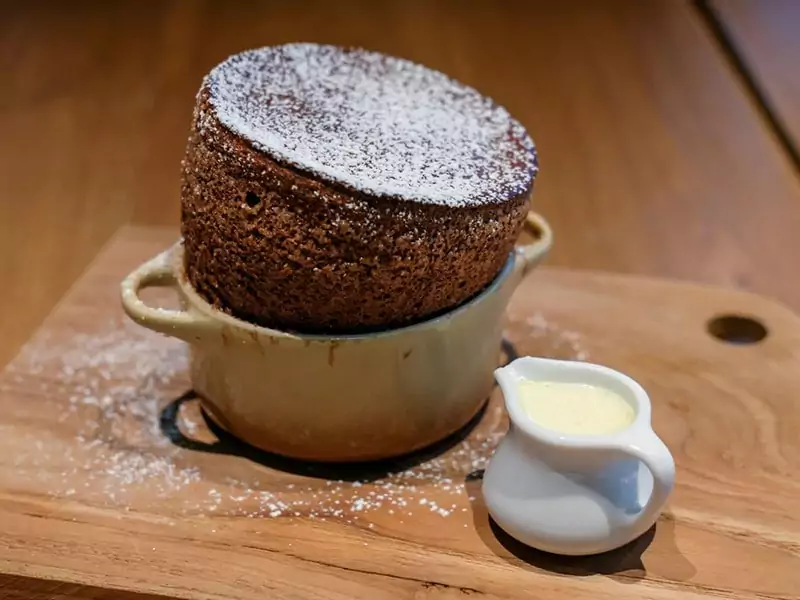
Named after the French verb “souffler,” meaning “to blow” or “to inflate,” a soufflé is a spongy and airy delight, coming in both sweet and savory versions. The egg yolk-based base is responsible for its flavor profile.
In a sweet soufflé, the base might be a chocolate custard or berry puree. On the other hand, the savory counterpart takes on a base of cream cheese, béchamel sauce, spices, or vegetables.
Beaten egg whites full of trapped air are mixed with the base to create this eggy treat. The flavor can be sweet or savory, depending on the base. Most importantly, the eggs must be beaten carefully, preferably with a standing mixer or handheld mixer at medium speed.
If you want to try making this dish at home, here are a few additional tips to enhance your cooking experience.
Use eggs that are at room temperature. Second, consider beating your ingredients in metal bowls for the best results. Lastly, when it comes to baking, opt for a specialized soufflé dish or a ramekin.
10. Madeleines (Shell-like Sponge Cake)
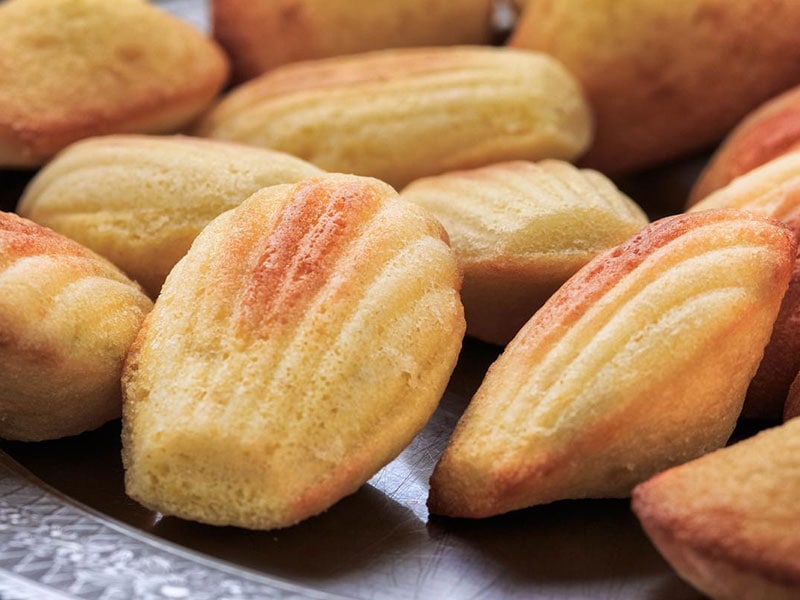
Madeleines, tiny sponge cakes that hail from Lorraine, have graced French tea tables since the 17th century. Though similar in size to cookies, they offer a sweet flavor and light texture more akin to cakes.
Featuring a signature shell-like shape, madeleines are a sight to behold, owing their distinct form to a special mold used during baking. Key ingredients of this buttery and sweet treat include flour, ground nuts, sugar, butter, and eggs.
Despite their petite size, madeleines are surprisingly airy, boasting an even lighter texture than full-sized cakes. Their subtle sweetness makes them the ideal companion to a cup of tea, coffee, or even a bowl of yogurt.
11. Riz au Lait (Rice Pudding)
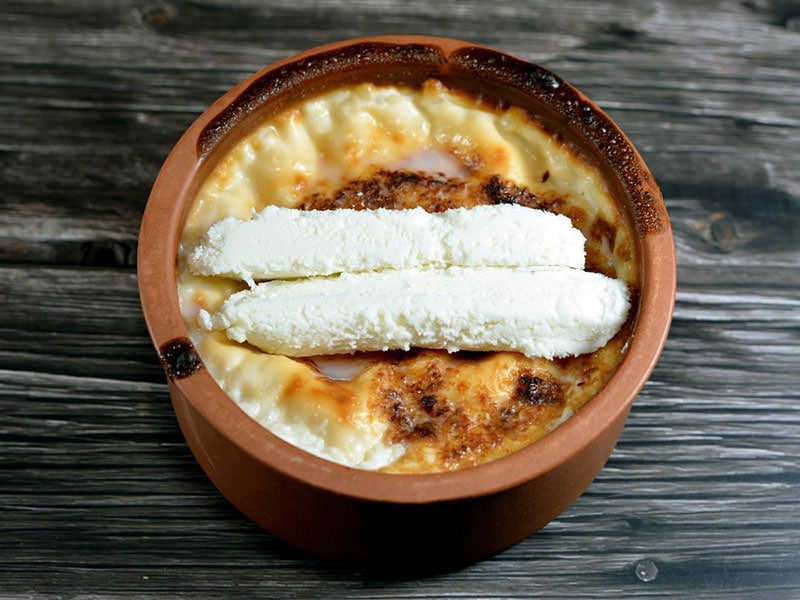
Riz au Lait, or rice pudding, is a creamy dessert with a rich history dating back to the 14th century. At a time when rice and sugar were expensive commodities in Europe, this luscious treat was a delicacy for the wealthy.
However, it had become a pleasure accessible to all by the 19th century. This dish is made by gently simmering short-grain, round rice (preferably Arborio or Carnaroli) in a blend of sugar, milk, vanilla, orange, and butter.
These types of rice are excellent at absorbing liquids, resulting in a wonderfully rich and creamy dessert. You might like to enhance the flavors with tasty additions such as ice cream, creamy caramel sauce, poached pears, or fruits with peanut butter.
12. Mousse
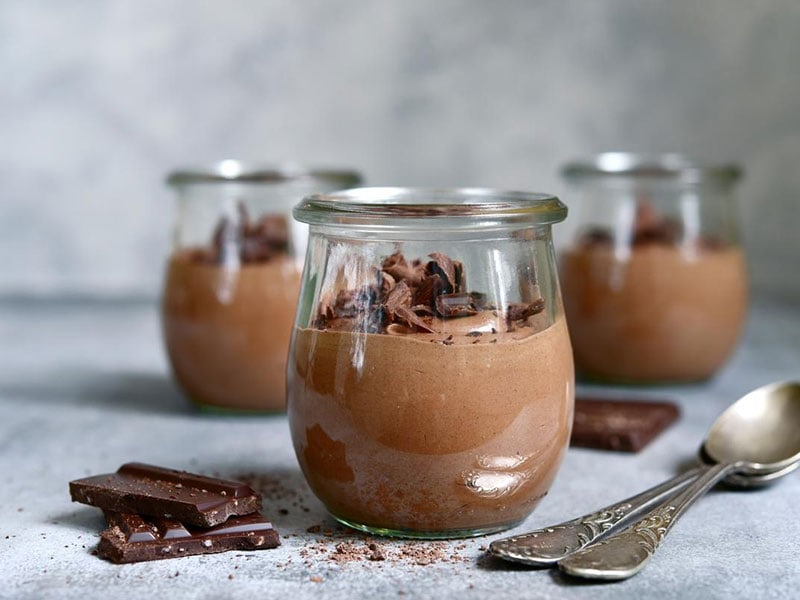
Mousse gets its name from the French word for “foam.” This name is no accident, with its spongy texture providing a hint of the aerated goodness inside. But it will gain a denser consistency after a chill session in the fridge.
Made from whipped cream, meringue, or egg whites, this flexible dessert needs no heat to come to life. That’s right: no cooking is required! The base can be flavor-infused, adding to its airy consistency.
Sweet mousse leans on ingredients like caramel, chocolate, coffee, and egg yolks, while savory mousse takes a walk on the wild side with foie gras, seafood, meat, and vegetables. As for pairings, fresh fruits or ice cream make excellent suggestions.
13. Escargot
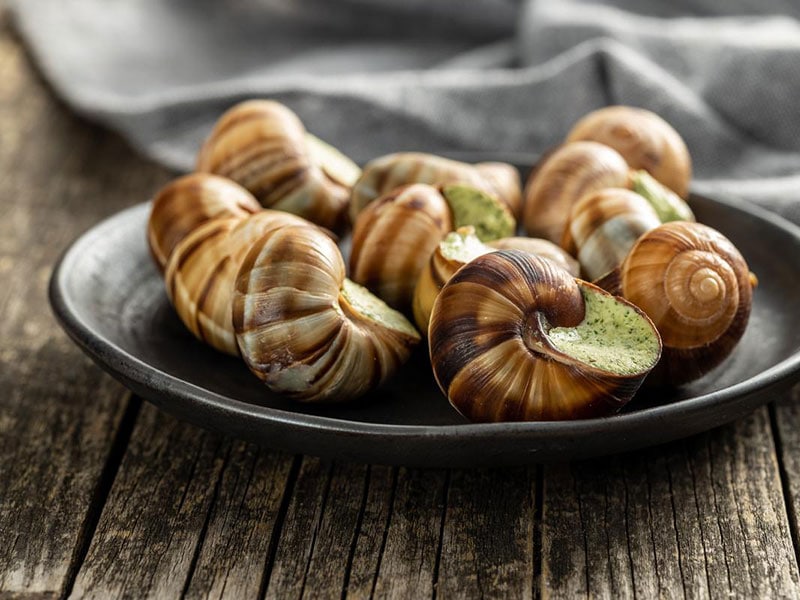
Escargot is a special dish in French cuisine that consists of edible snails. Once a budget-friendly choice available seasonally, it is now an esteemed delicacy with a hefty price tag, especially around Christmas time.
Among the numerous varieties, the garden snail, Burgundy snail, and Turkish snail win the popularity contest. As for its taste and texture, chewy mussels meet mild chicken or fish. Yet, there is also some earthiness reminiscent of aged mushrooms.
Escargot is traditionally prepared with a generous mixture of spices, herbs, and garlic butter to mellow its unique flavor. Don’t forget the crusty bread, a wonderful side for soaking up the succulent sauce.
As for food safety, the snails must be thoroughly purged before cooking. Do that, and you will enjoy a wonderful source of proteins, iron, calcium, and vitamin A [2].
14. Ratatouille (Provençal Stewed Vegetables)
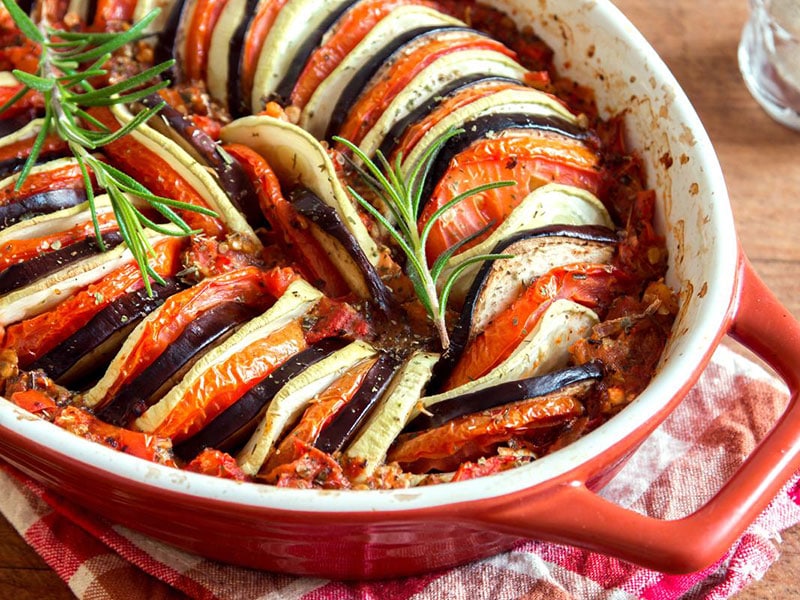
This vegetarian dish from Nice will make you forget about meat and dairy products. In it, eggplants, bell peppers, tomatoes, zucchini, and onions decorate the plate. These ingredients come together harmoniously, seasoned perfectly with Provençal herbs and garlic.
This vegetable medley results in a robust flavor profile with a tangy twist. Ratatouille can proudly hold center stage as a main dish, accompanied by French bread, steamed rice, or pasta, or gracefully share the spotlight as a side for cold cuts, sausage, ham, and the like.
It’s like its cousin, the Tian, a similar French vegetable-based dish. And who could forget the Pixar animated film that gave this dish celebrity status?
15. Crème Brûlée
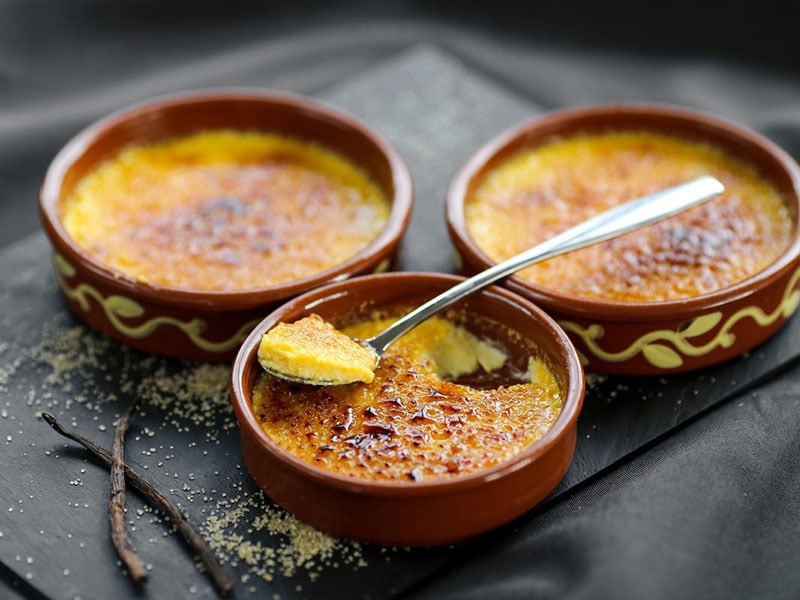
Crème brûlée, also known as burnt cream or Trinity cream, is a crowd-pleaser combining a velvety custard base flavored with vanilla. It is topped by a thin, crackly layer of caramelized sugar.
The best part is the satisfying crack as your spoon breaks the sugar crust, revealing the creamy custard beneath. A kitchen torch is necessary to achieve that perfect caramelization. But if you lack one, a grill lighter or a metal spoon heated for several minutes can replace it.
This water bath-baked dessert is high in sugar and fat and loves a chill before serving. A dash of fruits for garnish won’t hurt. And it should be served in a cute ramekin.
16. Soupe à L’oignon (Onion Soup)
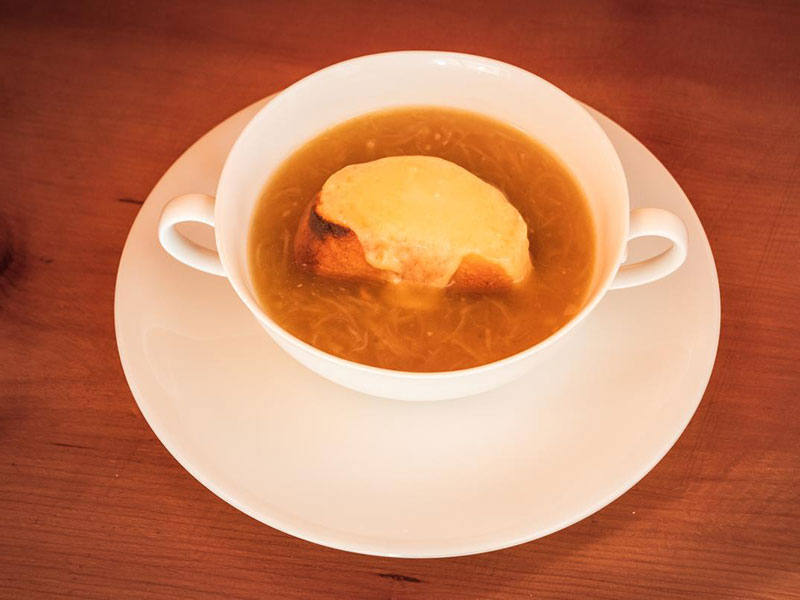
A humble bowl of Soupe à l’oignon (French onion soup) has been warming hearts since Roman times. It was once considered a basic dish for the less affluent. The modern version made its debut in the 18th century.
It is made by simmering caramelized yellow onions in rich beef stock and a splash of wine or brandy. Expect onions so tender they melt in your mouth, yielding a delightful sweetness that marries perfectly with the savory notes of the stock.
The soup should be served gratinéed with a crust of browned bread crumbs and cheese or simply adorned with croutons. Accompanied by crusty bread, roasted veggies, or a juicy steak, it’s a masterpiece in a bowl!
17. Steak au Poivre (Pepper Steak)
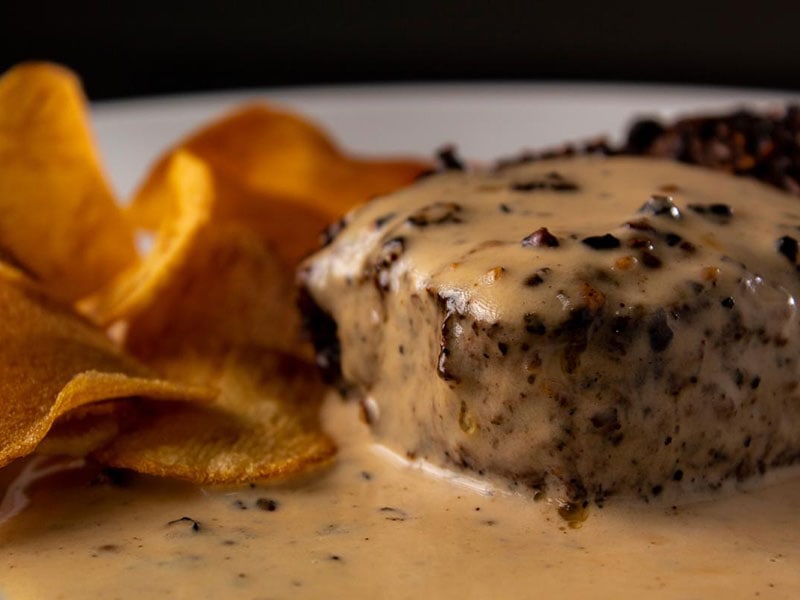
Normandy is home to a fantastic French delicacy: Steak au Poivre (pepper steak), which celebrates the beauty of a well-cooked steak – usually a top-quality filet mignon.
Locals prepare it by generously coating the steak with coarsely cracked peppercorns and then pan-frying it in oil or butter. Elevating it is a luxuriously smooth sauce, a perfect blend of cognac and heavy cream.
Pair this delicacy with some crispy french fries or a fresh salad for an unbeatable meal. And if you’re feeling a little adventurous, try its cousin steak Diane, a variant made with mustard.
18. Éclair (Oblong Choux Pastry)

Originating from Lyon in the nineteenth century, Éclair (also known as Pain à la Duchesse) is a sweet celebration of craftsmanship and flavor. Its creation begins with choux dough, a simple mixture of butter, sugar, eggs, and water.
Next, the chef will boil this combination before incorporating the flour, then patiently wait for it to cool before adding the eggs. Then comes the artful act of shaping this dough into an oblong form using a piping bag, followed by careful baking until it achieves a crisp exterior and a hollow interior.
These hollow vessels are then filled with a variety of creamy ingredients, such as custard (crème pâtissière), whipped cream, or chiboust cream. The last step is to seal them with a decadent topping of flavored fondant icing. A Religieuse is the round-shaped cousin of the Éclair.
19. Baguette
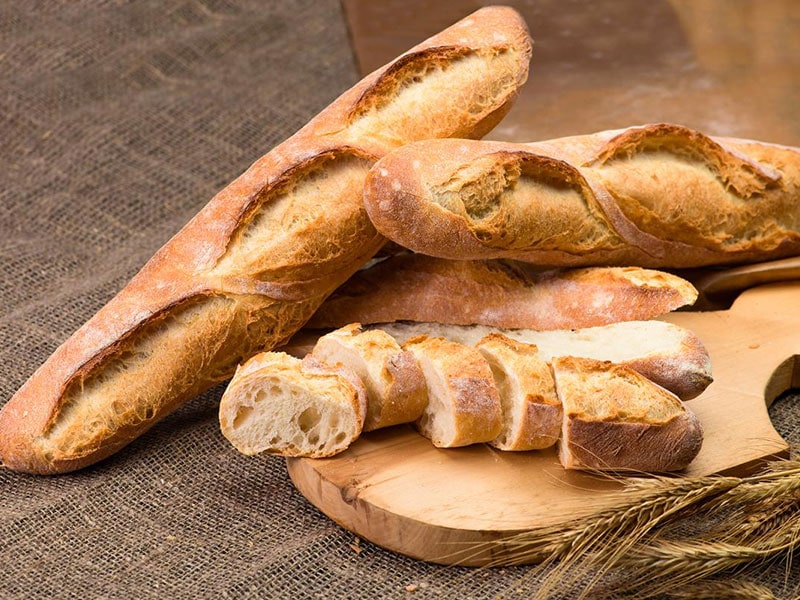
When I think of French cuisine, my mind wanders to the simplicity and perfection of a baguette. This long, thin bread relies on a basic lean dough. It sports a distinctive crisp crust and a chewy texture. Its diameter is about 2 to 2.5 inches, while the length can extend up to 3 feet.
I’ve seen the neutral-tasting bread cut into single-serving sizes or used as the backbone of a hearty sandwich. It can perfectly complement the flavor of everything, especially pâté or cheese.
Baguettes are wonderful with butter and jam, or you can dunk them into coffee or hot chocolate. Outside France, variations like the Vietnamese Banh mi have emerged, showcasing the diversity of this humble bread.
20. Bisque
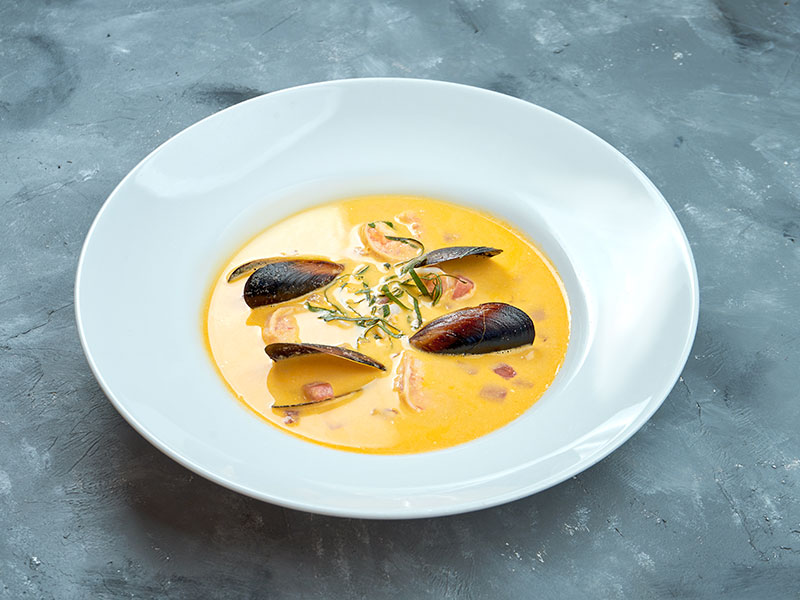
Nothing warms the soul like a bowl of Bisque, a creamy, luxuriously seasoned soup. Supposedly named after the Bay of Biscay, the classic bisque is based on a strained broth of crustaceans like lobster, crab, shrimp, or crayfish.
The seafood shells are ground into a fine paste and added for thickness, while the seafood meat mingles with onions, garlic, herbs, and sometimes a few veggies like leeks or carrots. This soup isn’t just for seafood lovers, as cream-based versions without seafood are widely available.
To deglaze the pan, add a dash of white wine, brandy, or sherry. The soup is further thickened with rice, strained out, or pureed to perfection. I love savoring it from a double-handled cup or a mug on a chilly day.
21. Steak Tartare
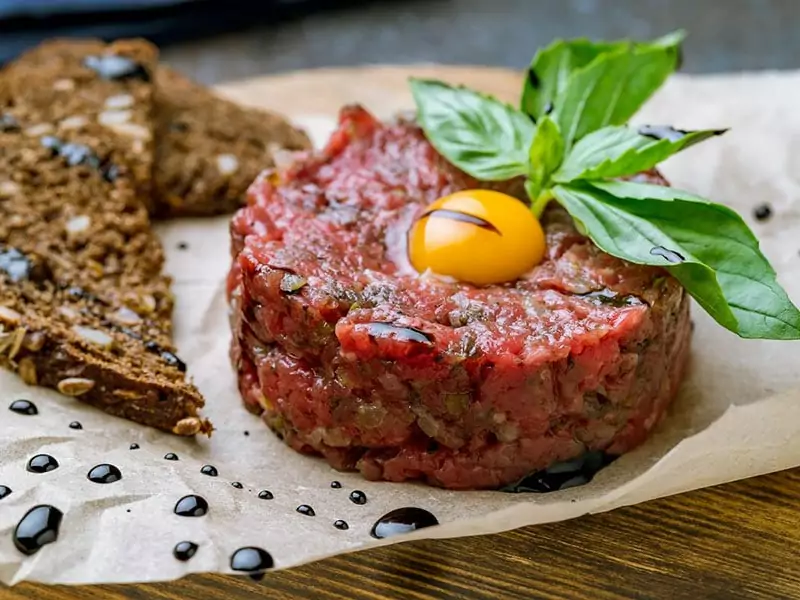
Steak Tartare, also known as tartar steak, is a raw meat dish made from finely minced beef. This preparation method is similar to those in various global dishes, including the Levantine Kibbeh Nayyeh, Turkish Çiğ Köfte, Korean Yukhoe, and Japanese sashimi.
The steak tartare is never alone, as it mingles with onions, capers, mushrooms, pepper, and Worcestershire sauce, each presented separately for consumers. Raw egg yolks often adorn the top.
Over in France, there’s a variant known as Tartare Aller-retour, which sees the raw mound of meat lightly seared on both sides. Despite some health concerns related to bacterial and parasitic contamination, Steak Tartare is generally safe to eat and a signature item in French cuisine [3].
22. Macarons

These sweet meringue-based confections are a play of colors and textures. Crafted meticulously with egg whites, almond meal, granulated sugar, icing sugar, and food coloring, they require the precision of a chemist and the creativity of an artist.
Making these sweets is not the simplest task. There are two primary techniques for their preparation. The first method is the French meringue approach, which requires the whisking of egg whites until they form a meringue with stiff peaks.
Powdered sugar and ground almonds are then carefully folded into the meringue. This technique results in shells with a crisp texture and an overall airier finish to the sweet.
In the Italian meringue method, whisked egg whites are combined with hot sugar syrup to form a meringue. Simultaneously, a paste of almonds and icing sugar is blended with raw egg whites. This technique leads to a softer shell on the outside while providing a chewy texture inside.
23. Brioche
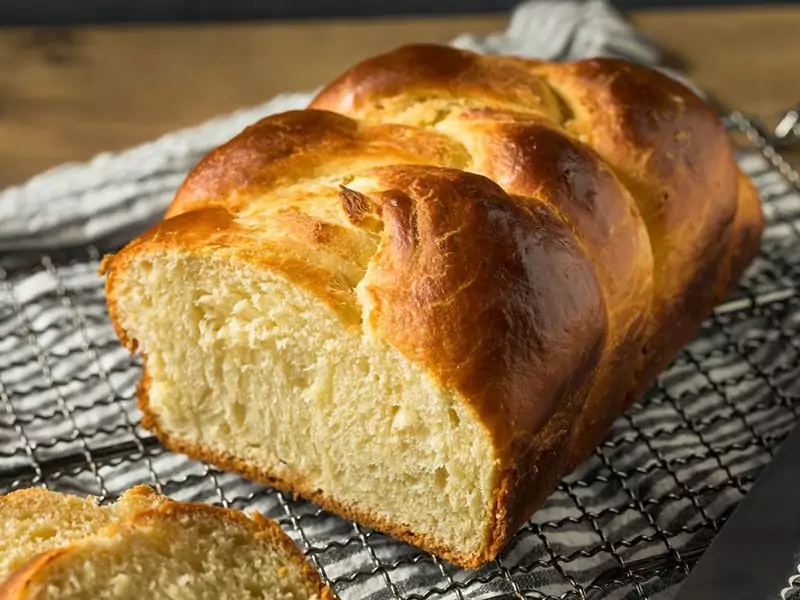
Brioche is known for its rich and tender crumb. This characteristic is due to its high content of eggs and butter, which lends the dough a somewhat puffy and light texture.
Depending on the proportion of these ingredients, the fineness of the crumb may vary. The exterior presents a golden and flaky crust, thanks to applying an egg wash during baking.
The flour-to-butter ratio can be as indulgent as 3:2 for a “rich man’s brioche” or a more modest 4:1 in the case of the economical pain brioché.
While this amazing French dessert is quite delectable on its own, you can include add-ins like fruit or chocolate chips.
Brioche can be enjoyed plain or filled with savory goodies such as beef filet en croute, sausage, or even foie gras in a dish known as coulibiac. The Brioche à tête or parisienne (baked in a round, flared tin) is probably the most iconic form.
24. Aligot (Cheesy Mashed Potatoes)
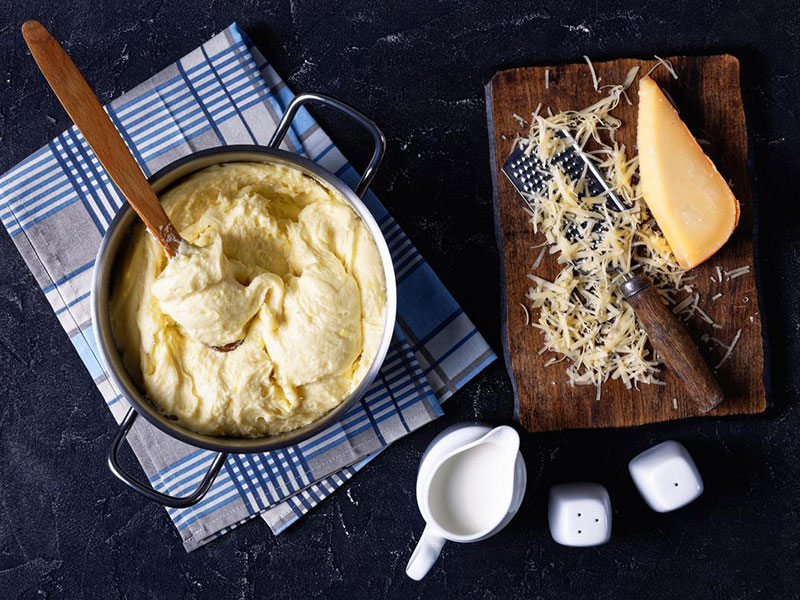
A culinary gem from the L’Aubrac region in the southern Massif Central of France, Aligot can be likened to a decadent fondue. This rich blend of mashed potatoes and cheese once served as sustenance for pilgrims on their journey to Santiago de Compostela.
The present form of Aligot has the addition of crushed garlic, butter, cream, and melted cheese. The cheese of choice is traditionally the Tomme de Laguiole or Tomme d’Auvergne. Meanwhile, a glass of Auvergne red wine is a classic accompaniment.
The dish was initially prepared with bread and potatoes. Today, Aligot stars as the main dish during village gatherings and celebrations. It is a common sight in Auvergne restaurants. In Aveyron homes and street markets, people still cook it by hand.
Belgian Cuisine
25. Moules-Frites (Mussels and Fries)
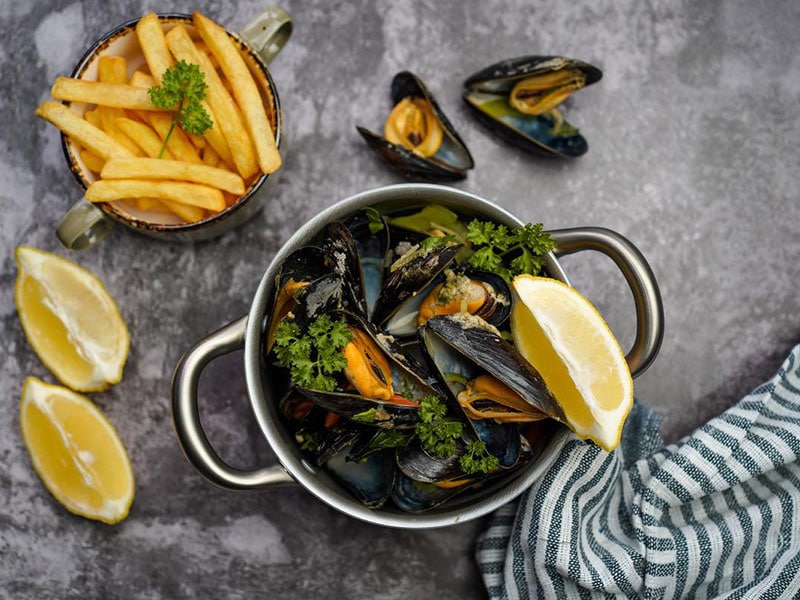
Though widely recognized as the national dish of Belgium, Moules-Frites is also much appreciated in France. You can easily spot Moules-Frites in traditional Belgian restaurants, ideally with a glass of beer on the side. Its main ingredients are steamed mussels and French fries.
The mussels are usually steamed with white wine, herbs, and shallots in a pot, while the potatoes are served separately. To enhance the flavors, a mustardy sauce accompanies the meal.
26. Belgian Waffle

Belgian waffles, crafted from a yeasted batter, stand apart from their American sibling thanks to their deeper pockets, which are ideal for holding delicious toppings like butter, chocolate, or fruit.
Each bite reveals a crispy exterior and a light, airy interior. As a dessert, a scoop of ice cream makes a wonderful addition. Breakfast lovers will be fond of these waffles.
Belgium boasts two primary varieties: the Brussels waffle, known for its rectangular edges, and the Liege waffle, a heavier, sweeter variant.
27. Waterzooi (Belgian Stew)
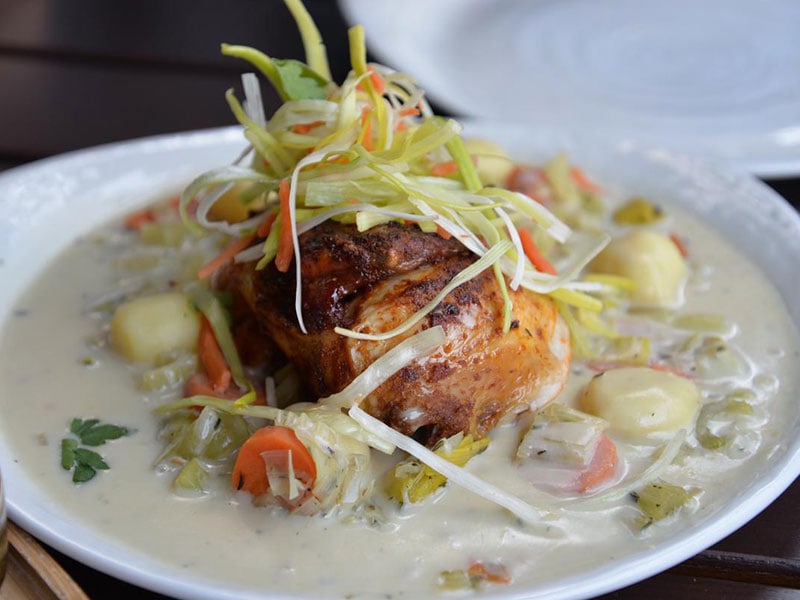
This Belgian stew hails from Ghent in Flanders and gets its name from the Flemish words meaning “boiling water.” This velvety and creamy dish typically includes chicken or fish, cream, egg yolk, broth, and a medley of vegetables such as carrots, leeks, and celery.
For fish-based waterzooi, pike, cod, bass, or other suitable fish are ideal choices. Some variations even incorporate additional seafood like shrimp or mussels. The key characteristic of waterzooi is its thickened broth, resulting in a rich and indulgent texture.
28. Speculoos (Belgian Biscuit)
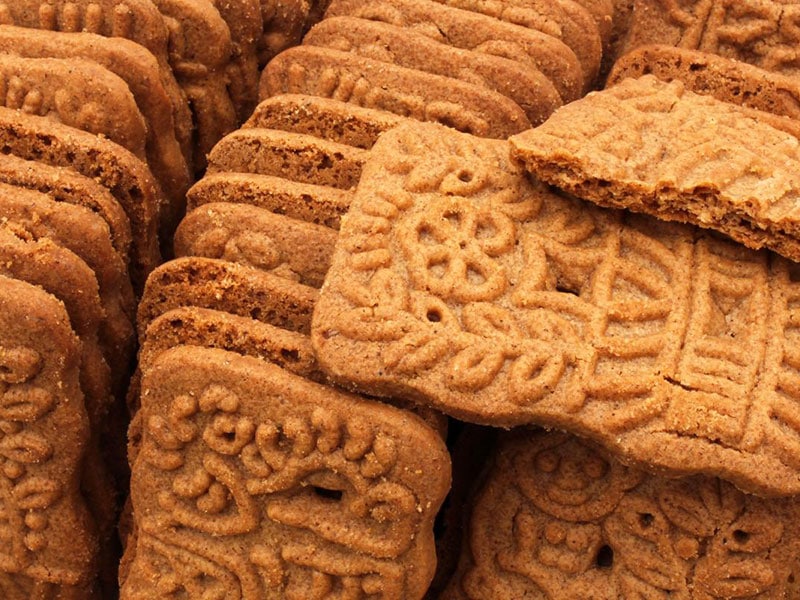
This crunchy and a little spicy shortcrust biscuit will be a treat for your palate. It’s a staple during holidays and special occasions across Europe. The simple recipe only uses flour, fat, syrup, and sometimes a pinch of cinnamon.
But it’s the spice story that makes this mind-blowing Belgian dessert stand out. In the old days, spices were quite costly to import to Belgium. Speculoos used fewer spices, so they were a more affordable alternative to the Dutch Speculaas.
In Europe, the Lotus brand offers some of the best Speculoos.
29. Paling in ‘t Groen (Eel in The Green)
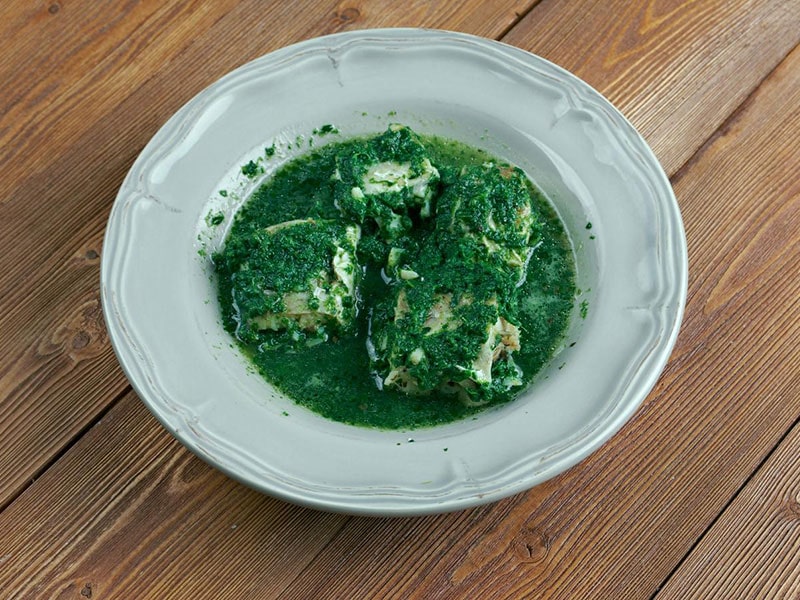
Eel in The Green is a stew from the early Middle Ages, in which freshwater eels swim in a sea of herb sauce. The sauce is a rich blend of freshly chopped herbs such as sage, chervil, parsley, mint, oregano, and more.
Preparing the eel is an art in itself. After a good clean and rinse, the gut, head, and tail are removed before being cut into smaller, manageable pieces. Next, people gently simmer these chunks of eel with herbs, white wine, and other ingredients.
In my experience, when the eel’s white flesh easily separates from the bone, it is ready. Remember to stir the stew gently to keep the eel pieces intact.
British Cuisine
30. Shepherd’s Pie
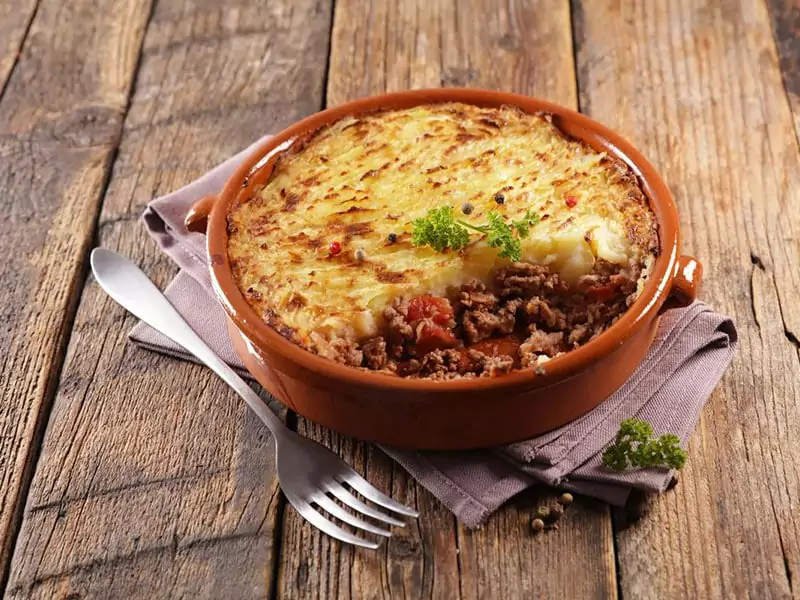
This traditional British dish isn’t your average pie. Rather than flaky pastry, it is a two-layer casserole. The base is made of minced meat (beef or lamb) and seasoned with garlic powder, black pepper, thyme, and parsley. On top of it is a layer of fluffy mashed potatoes.
This combination is assembled in a casserole dish and then baked to golden perfection. For an easy meal, the meat can be pre-cooked. You’ll find variations on this classic around the world: think cottage pie that exclusively uses beef or Hachis Parmentier in France.
31. Bangers and Mash
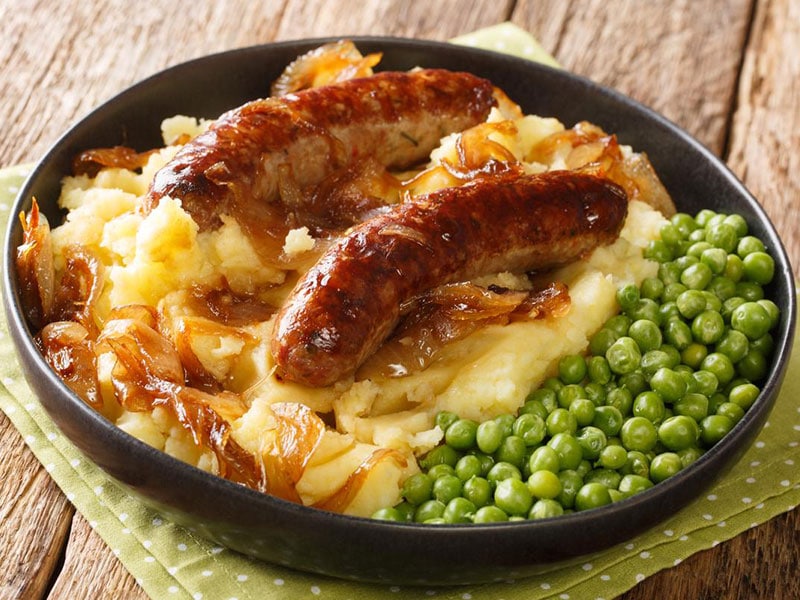
Bangers and mash is a homely dish featuring pan-seared sausages nestled in a fluffy bed of mashed potatoes. The sausages can vary from pork to beef or lamb. They’re lovingly referred to as “bangers” because of their tendency to burst while cooking.
A generous helping of thick onion gravy, peas, and fried onions typically accompanies this dish. Those mindful of their calorie intake can even switch out the mashed potatoes for cauliflower rice to keep the comfort while trimming down the guilt.
32. Full Breakfast
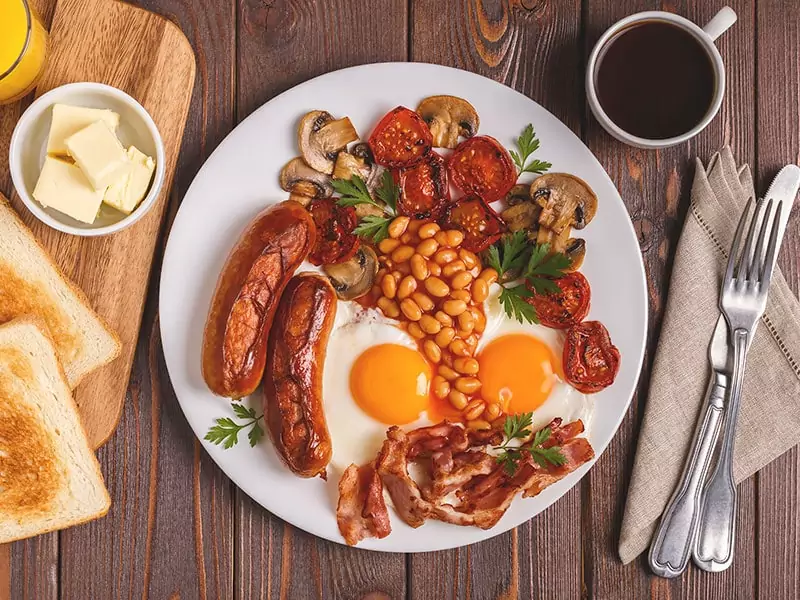
A full breakfast, also known as a “fry-up,” has a history stretching back to the 13th century. It is prevalent in the UK, Ireland, and several Commonwealth nations.
The lineup stars hearty sausages (pork is the go-to), black pudding, and bacon (remember that English bacon differs from the American variety). Then come the sidekicks: baked beans, mushrooms, tomatoes, eggs, and toast. These ingredients collaborate to build a breakfast that is both hefty and fulfilling.
However, you can easily find it as an all-day option in cafes and pubs. To round off this royal feast, a cup of coffee or tea is the perfect beverage.
33. Sunday Roast
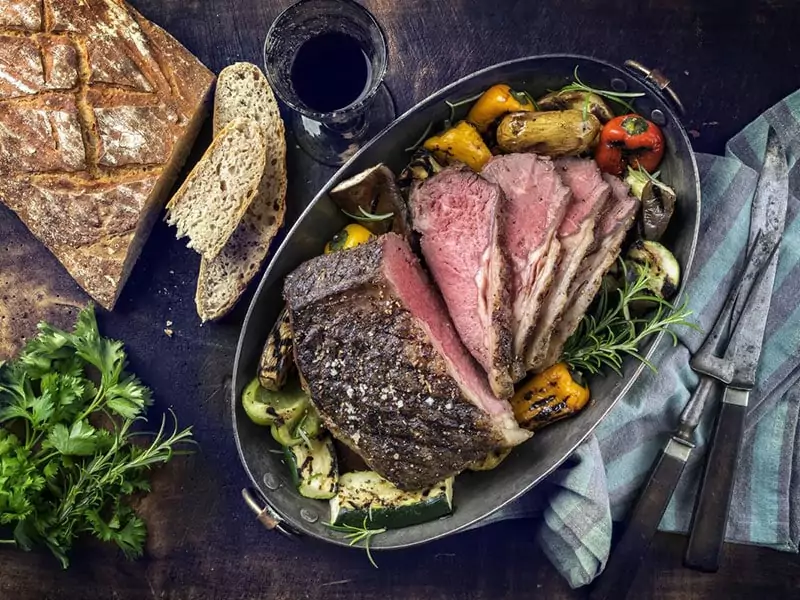
Also known as the roast dinner, this gem is prominent in British cuisine. While locals traditionally savor it on Sundays after church service, many people enjoy it for weekday meals nowadays.
This bountiful platter brings together roast meat, vegetables, and gravy, with a side serving of sauce. Beef, pork, chicken, or turkey could be the meat of choice. The undisputed crowd-pleasers, however, are the beef roast and Yorkshire puddings.
Tenderloin or rib eye roast would be great picks. Complementing the meat are vegetables like potatoes, broccoli, carrots, cauliflower, and parsnips. They can be prepared in various ways, from steaming and boiling to roasting.
34. Christmas Pudding
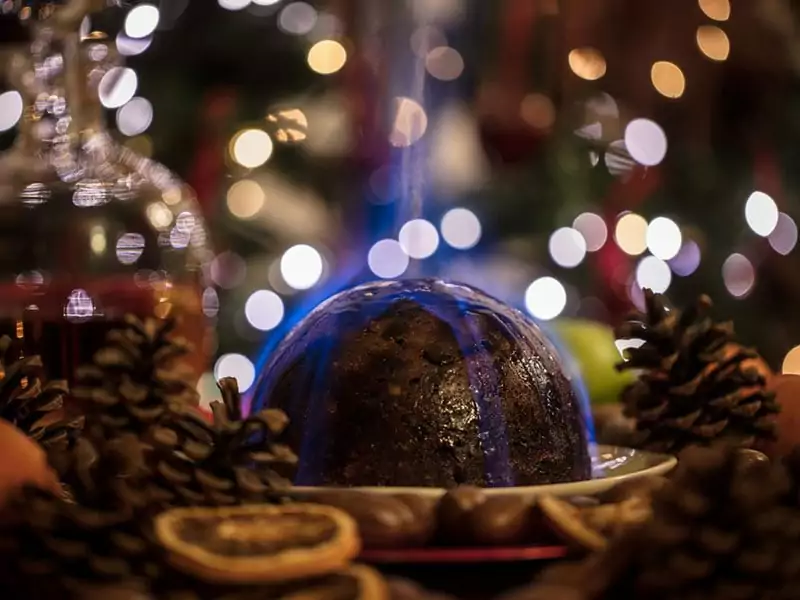
The Christmas Pudding is a sweet delicacy combining dried fruit, breadcrumbs, eggs, spices, sugar, and suet, among others. Traditionally, it should have 13 ingredients. Each ingredient represents Jesus and his 12 disciples.
The dark and sticky pudding can lure any foodie with its dense, moist texture. Brandy is poured over the pudding, and then the pudding is set alight. That fiery spectacle symbolizes the Passion of Christ, though many people suspect other origins [4].
Once the flames subside, it’s time to dig in. Some might opt for a spoon of clotted cream, while others prefer a scoop of vanilla ice cream to accompany the warm, spicy pudding.
35. Toad In The Hole

While the name might baffle you, “toad in the hole” is all about sausages nestled in Yorkshire pudding, which look like toads peeking from their burrows. An alternative name is “egg in the basket,” especially when eggs appear in the recipe.
All components come together in a baking dish, creating a cozy nest for the sausages. As it bakes, the batter turns delectably fluffy and golden. Next, veggies are served alongside the “toads,” plus a generous drizzle of onion gravy.
Whether you have it as a main course or include it in an English breakfast, this dish never fails to satisfy.
36. Pie and Mash
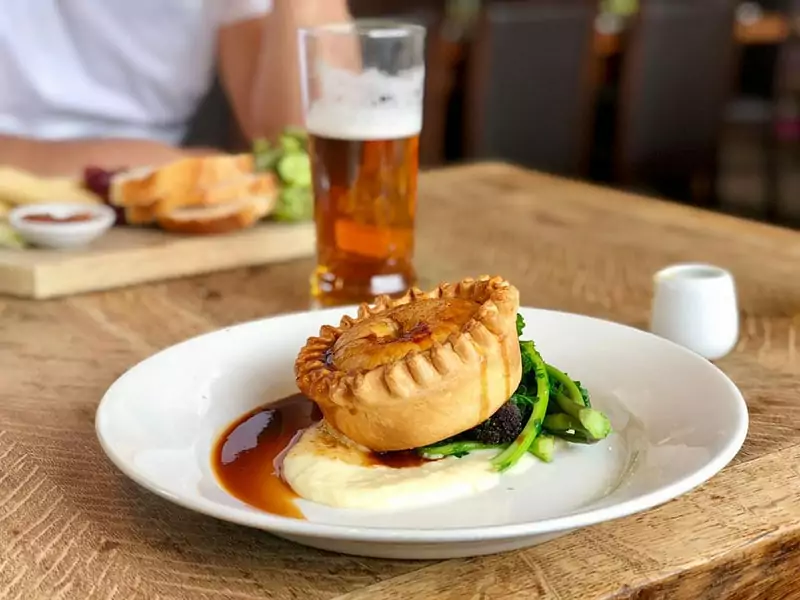
Pie and mash is a classic dish from London since the 19th century. It’s a cozy triad of a meat pie, mashed potatoes, and a green parsley sauce affectionately known as ‘liquor.” The meat pie is crafted from minced beef, snuggled within a pastry crust.
Back in the day, this crust served a dual purpose – a yummy bite for the hard-working class and a barrier shielding their portable meals from dirt. This meal is especially loved in East and South London.
Drizzle your pie and mash generously with liquor, then season with a touch of salt and vinegar for that extra kick of flavor.
37. Fish and Chips
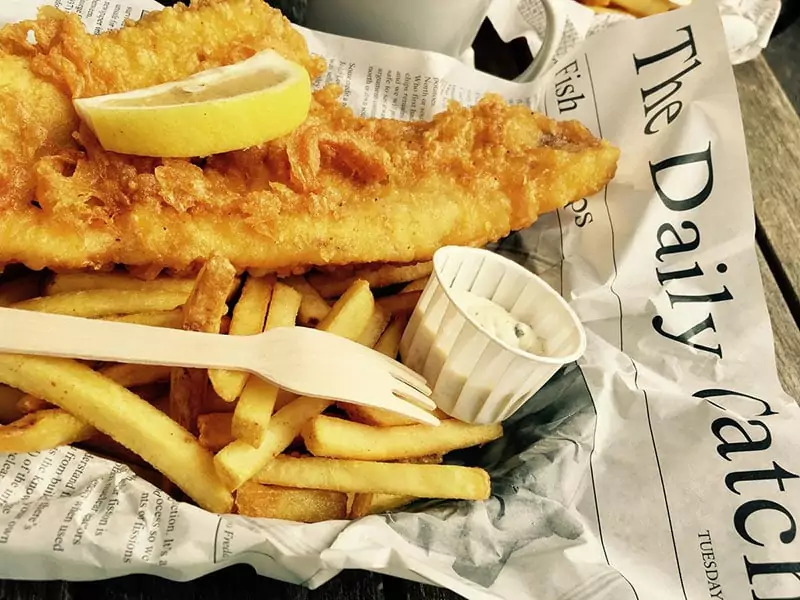
Fish and chips is the quintessential take-away food of the UK. The succulent, thick fish part utilizes white fish such as cod, pollock, or haddock, which is swaddled in a special batter. For that irresistible crispiness, the batter must contain beer and sparkling water.
The fish is then fried until golden and paired with equally crispy chips. Traditionally, this comfort meal was served in newspapers, a practice that, while less common today, still holds its charm. Nowadays, most people opt for plain paper or a cardboard box to carry this hot feast home.
A wedge of lemon and a sprinkle of parsley can heighten the flavors beautifully. Whenever I’m in the UK, I often frequent shops like Catch in Glasgow, Harbour Lights Fish & Chips in Cornwall, or Fish City in Belfast to try the best fish and chips.
38. Trifle

The making of this layered dessert starts with preparing a bed of sponge cake or sponge fingers by soaking them in sherry wine to deepen the flavors. Next, you add layers of whipped cream and succulent fruit, such as strawberries.
Some trifle variations may incorporate custard, coffee, chocolate, or even jelly for an exciting twist. The dessert is best made ahead of time to allow the flavors to intermingle and develop. Waiting between 4 to 24 hours will yield the best results. Don’t forget to chill it.
Do so, and you will have an ideal holiday treat that delivers a sweet, creamy, and fruity finish to a festive meal.
39. Chicken Tikka Masala
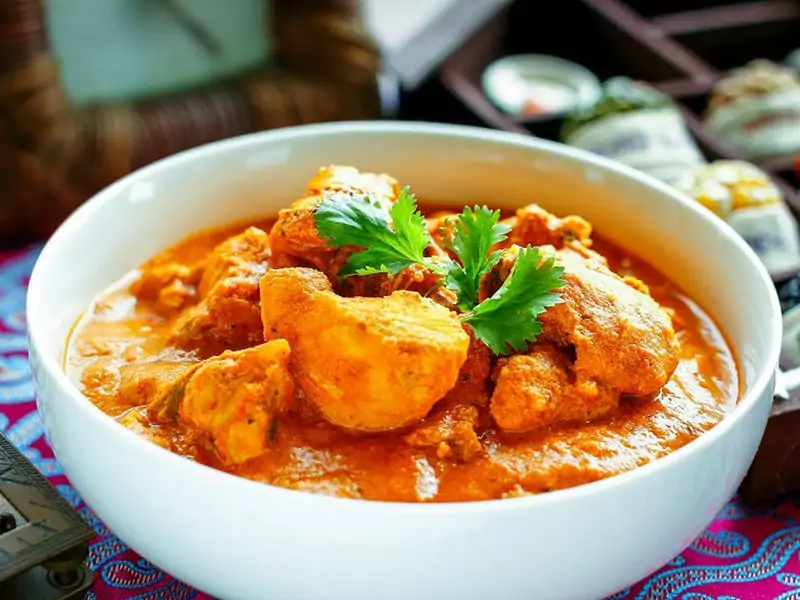
Despite having roots in Indian cuisine, chicken tikka masala is adored by British people. In 2001, British Foreign Secretary Robin Cook praised the dish as a symbol of Britain’s inclusiveness. No surprise that chicken tikka masala is a favorite on British dinner tables.
This bold-tasting dish consists of roasted, marinated chicken chunks (called chicken tikka) immersed in a well-spiced sauce. This combination creates an enticing blend of flavors that satisfies the British fondness for meat in a hearty gravy.
40. Haggis
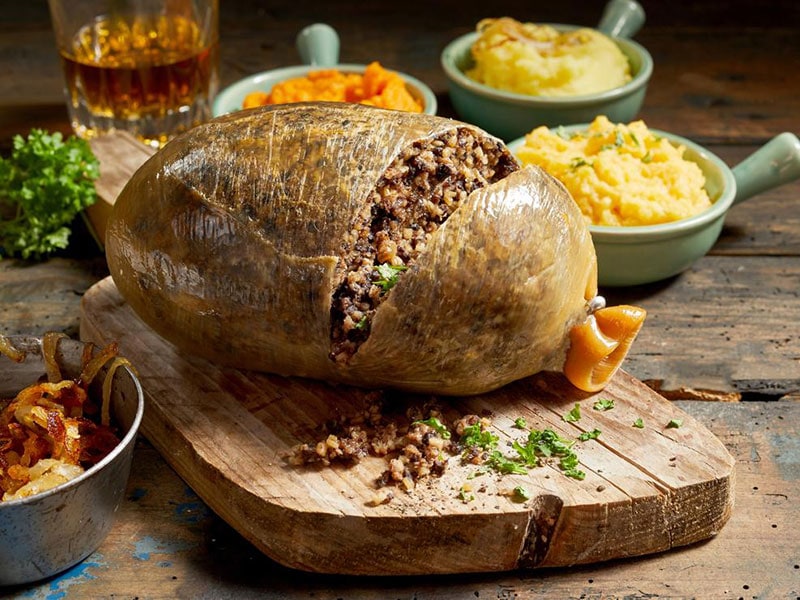
Known as Scotland’s national dish, Haggis is a hearty dish that encapsulates a blend of sheep’s offals (think liver, lung, and heart), onions, beef suet, oatmeal, and spices. This flavorful mixture is traditionally encased within an animal’s stomach.
Each crumbly bite is meaty, savory, and subtly oaty. Pairings include mashed potatoes (locally known as “tatties”) or turnips (“neeps”). A drizzle of whisky sauce completes the warm and hearty nature of the dish.
41. Scotch Pie
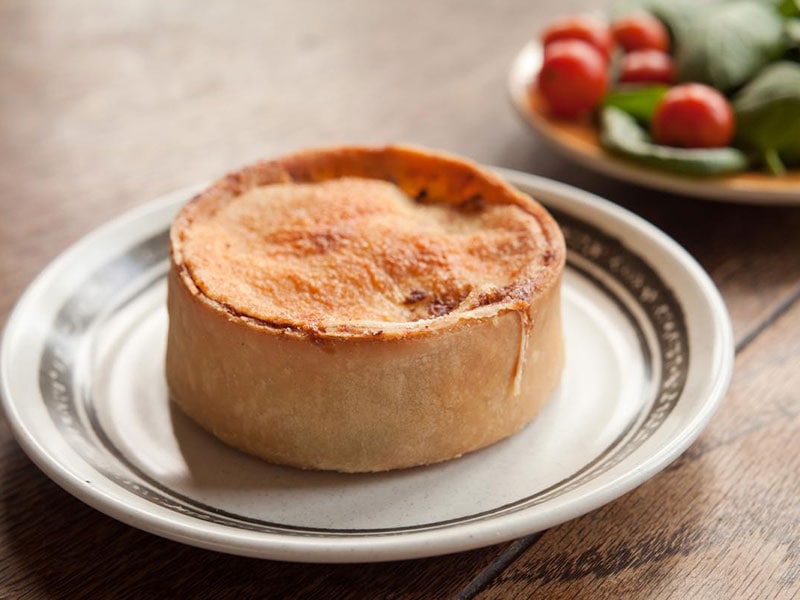
The Scotch pie goes by many other names, like mutton pie or mince pie. This small, double-crusted pie can give you a taste of authentic Scottish flavor as it cradles a perfectly spiced filling of minced mutton or other meats, such as beef or lamb.
One defining characteristic is the use of ”hot water pastry,” which isn’t too flaky and has just the right texture to firmly hold the wet filling inside. This special crust retains its shape beautifully, even when cooled.
You can conveniently eat a Scotch pie with your hands. Savor it hot or cold, and consider pairing it with traditional side dishes like baked beans and chips.
42. Cawl
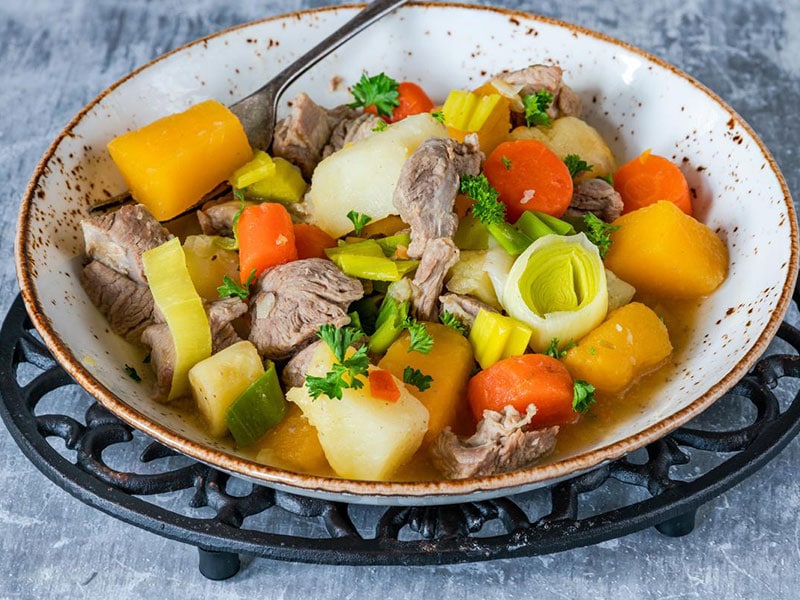
Cawl is a wholesome stew whose ingredients can change based on region or season, but the constants are medium-sized pieces of lamb or beef, potatoes, leeks, swedes, and carrots. The meat and veggies are simmered together in stock or water.
Upon serving, the nourishing broth comes first to set the tone. Then, for the second course, you’re presented with the meat and vegetables. And to perfectly round off this Welsh feast is a side of bread and cheese. No wonder why cawl is the national dish of Wales!
Dutch Cuisine
43. Stamppot (Mashed Potatoes With Other Vegetables)
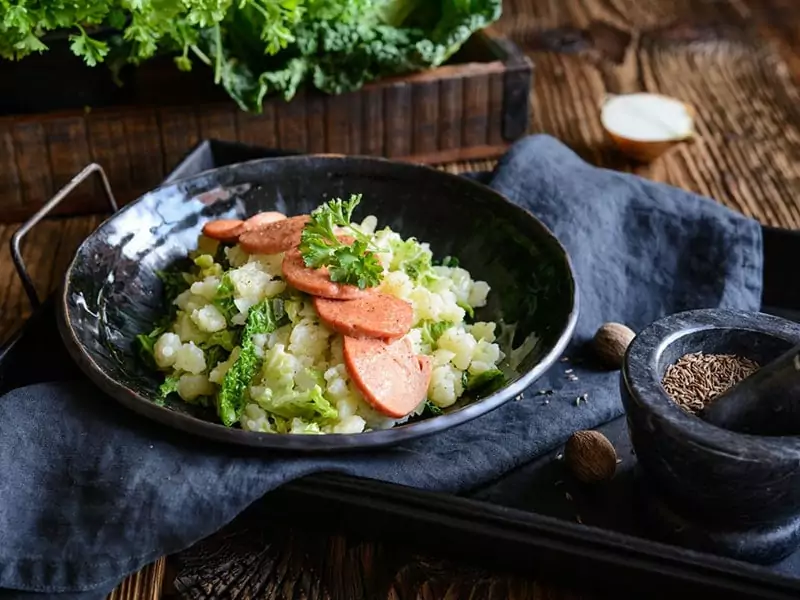
Made from boiled or mashed potatoes, this hearty Dutch delicacy takes on various forms. For instance, the addition of kale transforms it into Boerenkool Stamppot. Swap kale for carrots and onions, and you’ve got Hutspot.
The key here is in the preparation, with potatoes and vegetables being cooked solo in separate pots before they unite. Traditionally, a well-cooked Dutch sausage like Rookworst, bacon, or other meats become faithful companions to this dish.
As for some tang, sides such as pickled onion, gherkins, and cheese, step in. Whether homemade, picked up from the supermarket, or served in a cozy cafe-restaurant, Stamppot promises a wonderful trip into Dutch tradition.
44. Coleslaw
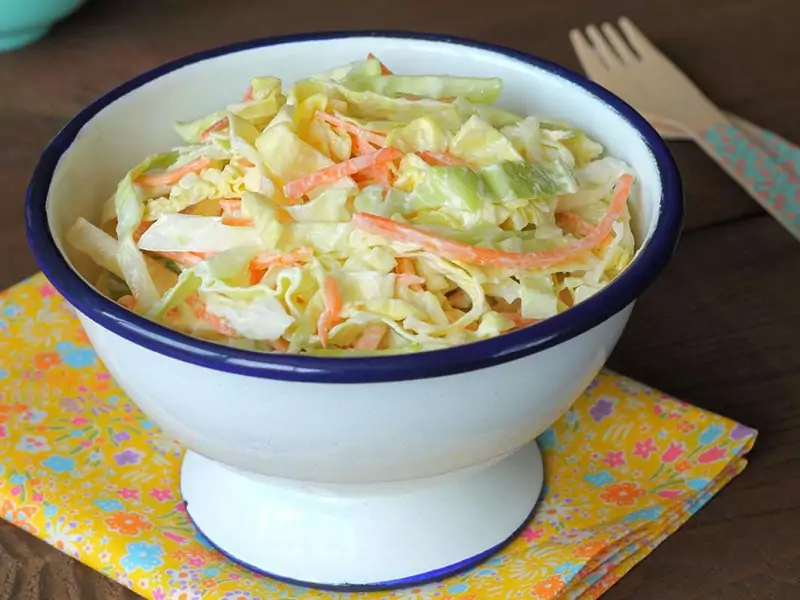
Coleslaw (or cabbage slaw) carries its roots from the Dutch, where it translates to “cabbage salad.” Every cabbage variety is acceptable as long as it is shaved and julienned.
Some twists to the classic include additions like carrots. The signature coleslaw tang comes from a salad dressing that can be a sour vinaigrette or a creamy mayonnaise-based concoction.
This iconic side dish is ideal for preparing in advance. With a low-calorie count and an abundant supply of vitamin C, K, and fiber from the cabbage, it’s also a health booster that gives your immune system that extra push [5].
45. Stroopwafel (Syrup Waffles)
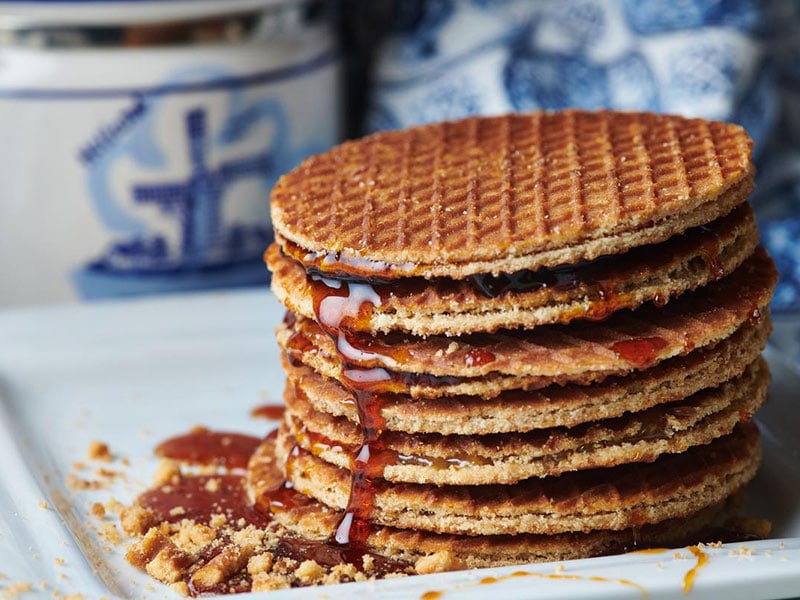
Stroopwafel (literally “syrup waffle”) comprises two thin, crispy waffles and caramel syrup in between. Created from a batter of brown sugar, flour, yeast, butter, milk, and eggs, the waffles find their perfect crispness in a hot waffle iron.
For the filling, a blend of butter, cinnamon, sugar, and syrup comes together and is spread between the two waffles. Once cooled, the syrup bonds the waffles into a singular, mouthwatering treat.
You’ll find a contrast in flavors, with the outer waffle maintaining a reserved sweetness while the filling captivates you with its rich caramel notes.
Traditionally, these treats are savored by resting them atop a hot cup of coffee, tea, or chocolate. The warmth from the drink gently softens the syrup inside, enhancing the overall taste.
46. Poffertjes (Mini Pancakes)
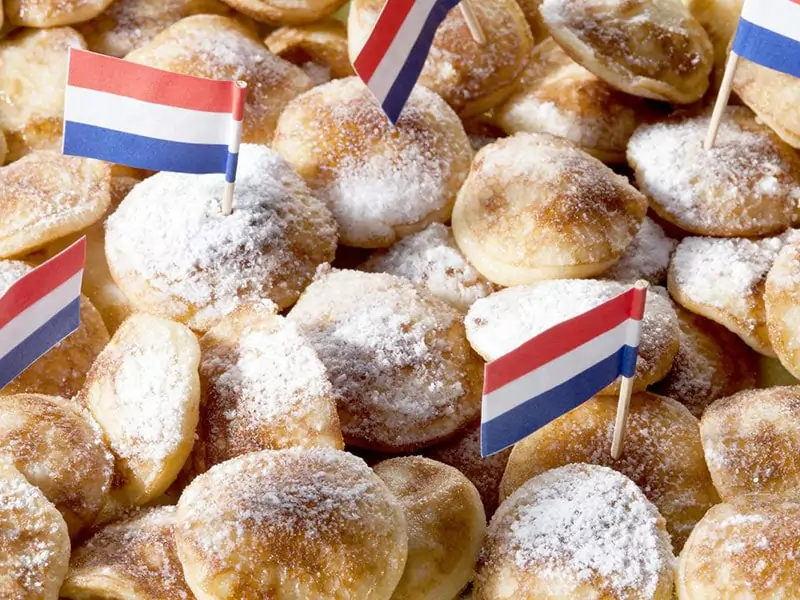
Poffertjes take the form of mini pancakes. While they add charm to holiday celebrations in the Netherlands, these festive and sweet wonders are no strangers to everyday scenes as a common street food snack.
The recipe calls for yeast and flour, a duo that contributes to their soft, pillowy texture. Special cast-iron pans are also necessary. The toppings play an important role, too, with powdered sugar and butter providing a traditional finish. Modern alternatives include whipped cream and syrup.
These morsels bear a resemblance to the Æbleskiver pancakes found in Denmark. If you ever wander through Dutch supermarkets, don’t miss out on the ready-made Poffertjes. I know I won’t!
47. Bitterballen (Dutch Meatballs)
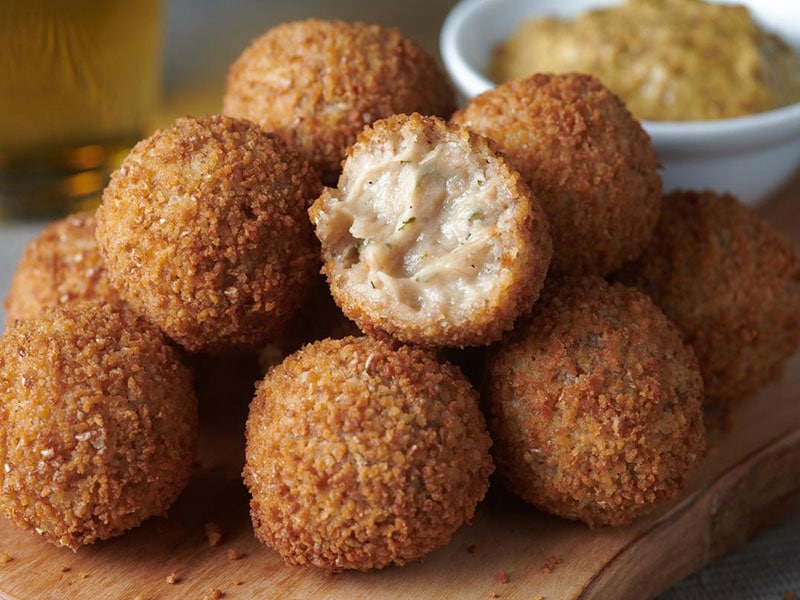
Dutch meatballs are immensely popular as a snack. The key players in their creation include minced beef or veal, a rich roux, and savory beef stock.
The process begins with cooking these ingredients along with chopped onions, carrots, and various seasonings. This mixture then takes a long rest in the refrigerator, ideally for at least 3 hours. For a vegan spin on this snack, mushrooms make an excellent meat substitute.
The next step sees the cooled mixture taking shape into one-inch balls, often with the help of an ice cream scoop, to ensure uniformity. Though round is the traditional shape, some variants are oblong.
Each ball then gets a triple coating treatment: first in flour, then egg, and finally breadcrumbs. A dip in hot oil deep-fries them to perfection. Finally, serve the hot meatballs with spicy mustard and a cold biertje (beer).
48. Erwtensoep (Split Pea Soup)
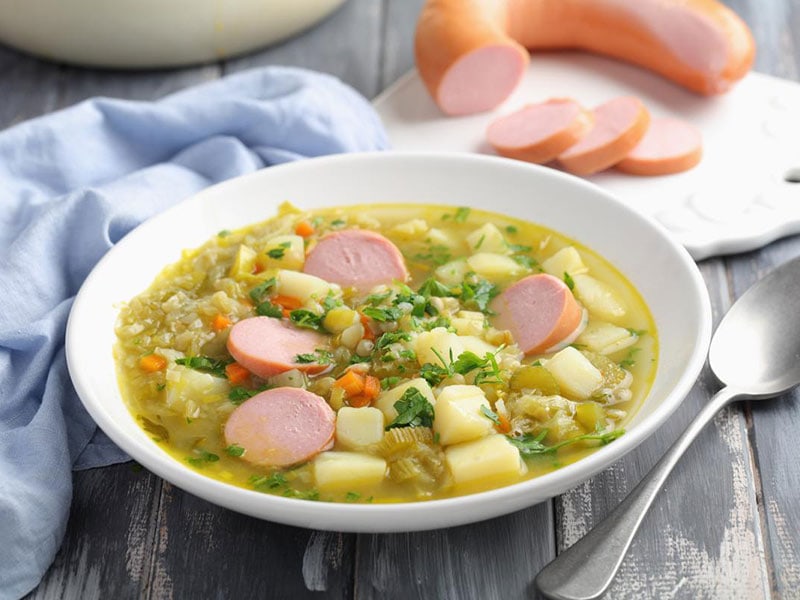
Erwtensoep, pronounced “Air-ten-soup” and affectionately known as “Snert,” can proudly lay claim to being the national soup of the Netherlands. This warming dish typically makes an appearance mostly during winter.
The ingredient list comprises green split peas, pork, celery, celeriac, onions, and carrots. When celeriac is out of stock, potatoes make a fine substitute. If green split peas aren’t available, yellow variants can step in, although the green ones are better due to their sweeter flavor.
Erwtensoep is thick by nature and usually accompanies Rookworst and crusty bread for a complete meal. If your soup seems too thin, a slurry made from cornflour and milk can help you achieve the right thickness.
49. Kibbeling (Fried Fish Snack)
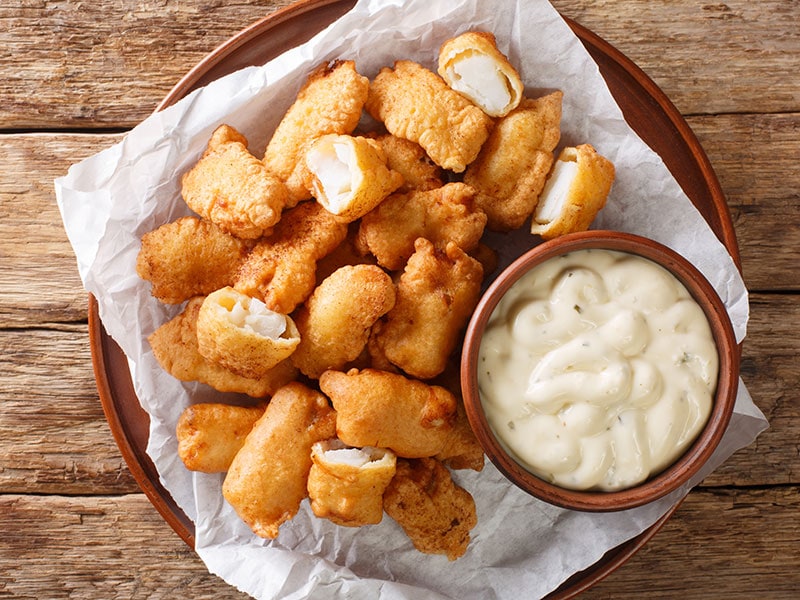
Kibbeling, a fried fish snack, is a must-try when you visit the Netherlands. Its name refers to the remains of a fish, specifically cod’s cheeks, which was originally the main ingredient.
But present-day Kibbeling incorporates an assortment of fish, including haddock, whiting, and pollock. You’ll find this popular snack and street food cooked at home or served hot from fish stalls at local markets.
Kibbeling is usually paired with a dipping sauce. Choices range from tangy garlic sauce to creamy, mayonnaise-based ones.
Irish Cuisine
50. Irish Stew
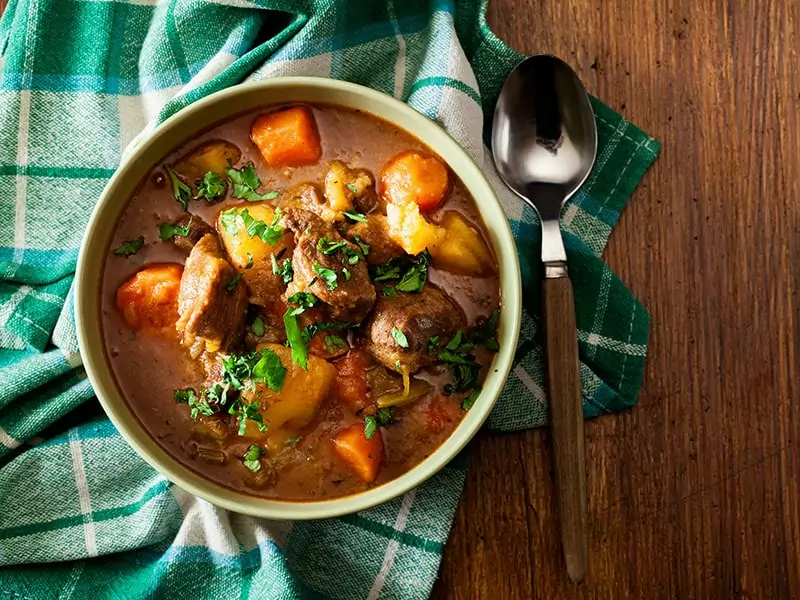
Irish stew strongly reflects Irish culture and endurance. It combines lamb/mutton, root vegetables like potatoes and carrots, and beef stock (optional). Simple seasonings of salt and pepper are more than enough.
This iconic delight in Ireland requires flour and hours of cooking to create a thick and satisfying texture. Serve it alongside Irish soda bread, rice, or a fresh salad for a complete meal.
51. Irish Soda Bread
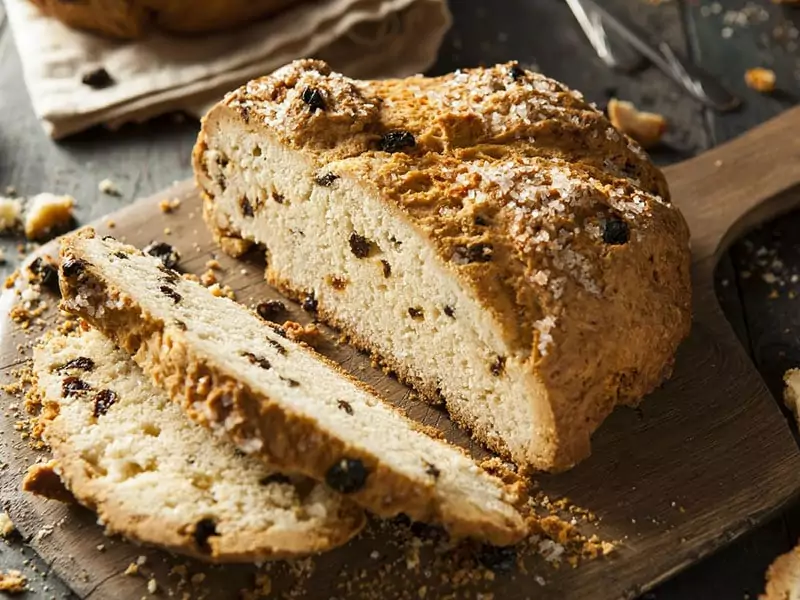
Irish soda bread stands out from the traditional ones because it doesn’t rely on yeast. With just flour, baking soda, buttermilk, and salt, it is quicker to make than yeast-based bread.
While the basic recipe is simple, you can also add ingredients like raisins, butter, or eggs for added flavor and texture. Its mild taste pairs well with butter, jam, or hearty meat dishes.
Its texture is crumbly yet moist. When baking, aim for a temperature of 200°F to 210°F. The bread tends to dry out quickly, so it’s best enjoyed within a day or two.
52. Colcannon (Mashed Potatoes with Cabbage)
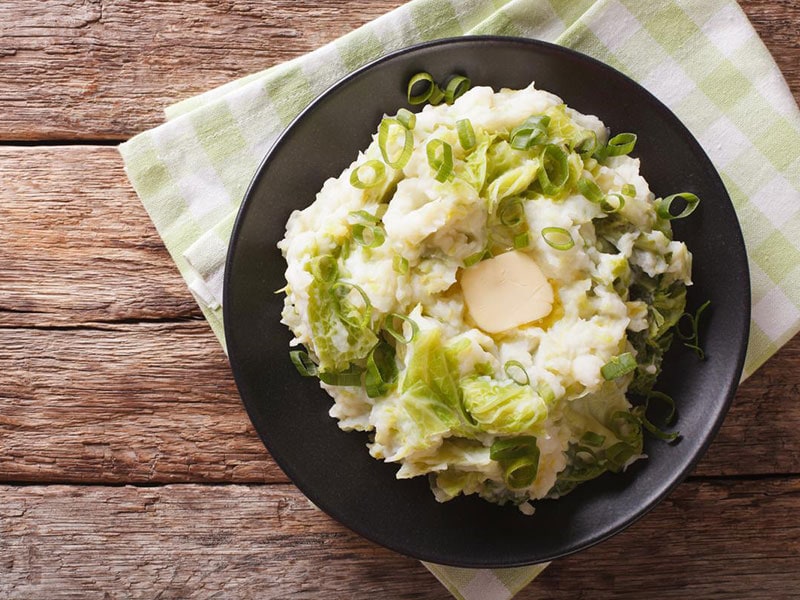
This beloved St. Patrick’s Day favorite is a delightful combination of mashed potatoes and cabbage. The other ingredients include kale, milk, and butter. You can also find variations with leeks, chives, or green onions.
When serving this creamy and buttery dish, place a generous pat of butter in the center of a mound of mashed potatoes and cabbage. Add meaty dishes like corned beef, and an authentic Irish meal is ready.
53. Barmbrack
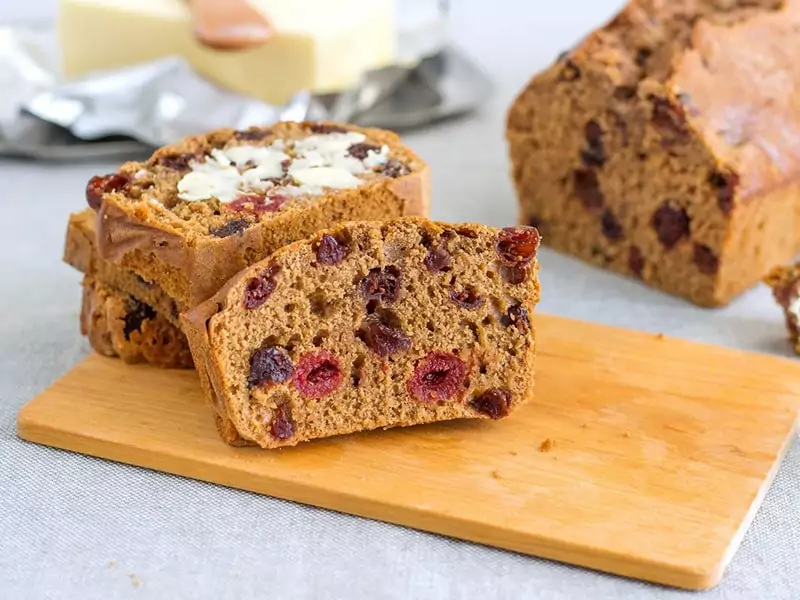
Barmbrack, also known as Bairín Breac or “speckled bread,” is a yeast bread with a mildly sweet taste, unlike regular cakes. The main ingredients include flour, sugar, baking soda, eggs, raisins, and sultanas.
Local traditions involve soaking dried fruits in tea or whiskey before combining them with the other ingredients. Locals often spread butter on the bread and serve it with a cup of tea.
This bread holds significance during Halloween, a special time in ancient Celtic traditions. Locals often bake Barmbrack and infuse it with Druidic charms such as a pea, cloth, coin, or ring.
Each item symbolizes a different fortune for the recipient, adding a fun element to the enjoyment of the bread. Today, Barmbrack continues to be a staple during Halloween celebrations in the country.
Luxembourgian Cuisine
54. Bouneschlupp (Green Bean Soup)
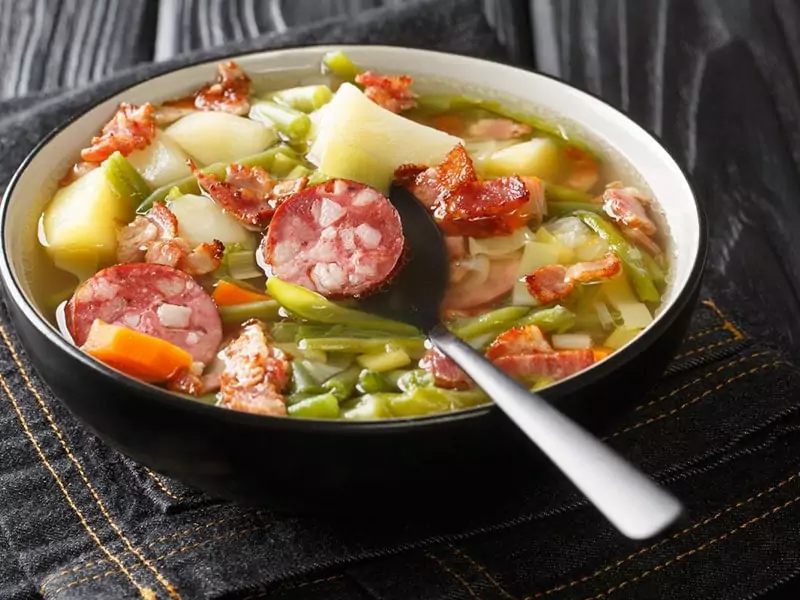
This beloved Luxembourgish dish is a comforting green bean soup. It brings together ingredients like green beans, potatoes, onions, and bacon to create a flavorful combination. If you’re looking for an ideal choice for a simple dinner, Bouneschlupp won’t let you down.
Depending on personal preferences, additional ingredients can be included. Some opt to add a roux to thicken the soup to their liking. A garnish of sour cream and a slice of Mettwurst sausage are the cherries on top.
55. Judd mat Gaardebounen (Smoked Pork and Broad Beans)
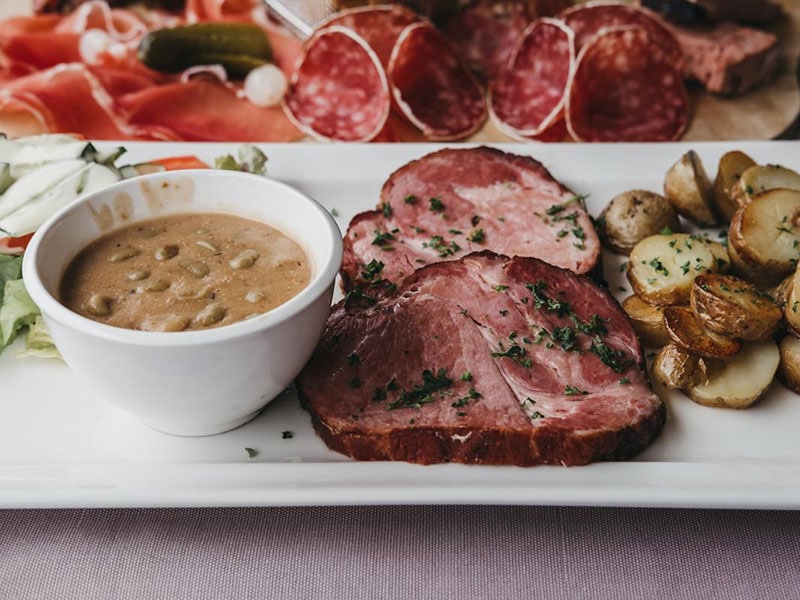
This delicious dish consists of smoked pork and broad beans. One of Luxembourg’s most popular national dishes, Judd mat Gaardebounen is closely associated with the village of Gostingen, which cultivates high-quality broad beans.
To prepare it, the smoked pork is soaked overnight and then simmered with a medley of veggies like onions, carrots, and leeks until tender and flavorful.
The broad beans are blanched, and next comes the step of creating a luscious sauce from roux, wine, stock, bacon, and aromatic spices (like peppercorns, bay leaves, and cloves).
Once the pork is cooked, it is served alongside the beans and sauce. For accompaniments, you can’t go wrong with boiled potatoes or a glass of wine.
56. Kniddelen (Luxembourgish Dumplings)
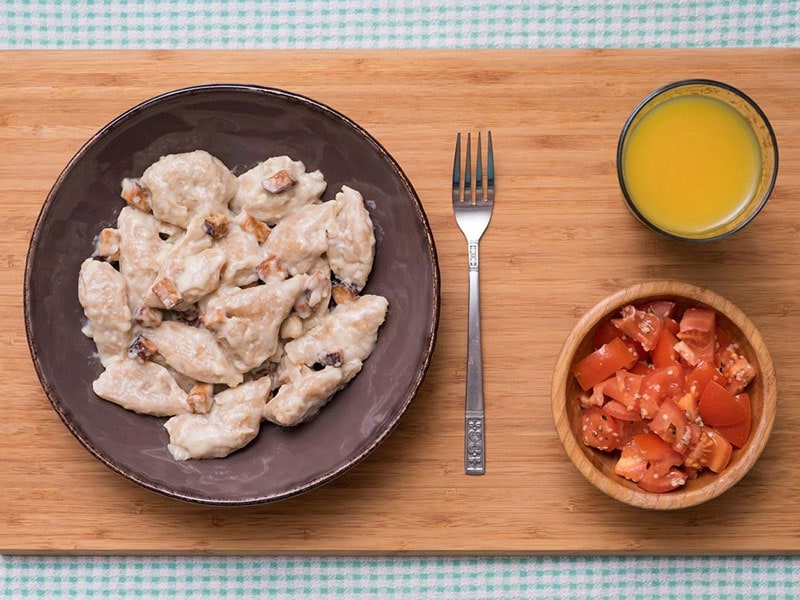
Kniddelen are soft and comforting boiled dumplings made from a simple mixture of flour, milk, egg, and salt. Traditionally, they are served with crispy bacon and apple sauce, creating a delightful sweet and savory combination.
However, they also pair wonderfully with cheese or cream as delicious toppings. These dumplings are best enjoyed piping hot, especially during the colder months. You can often find Kniddelen being served at festivals or Christmas markets throughout the country.
57. Quetschentaart (Damson Tart)
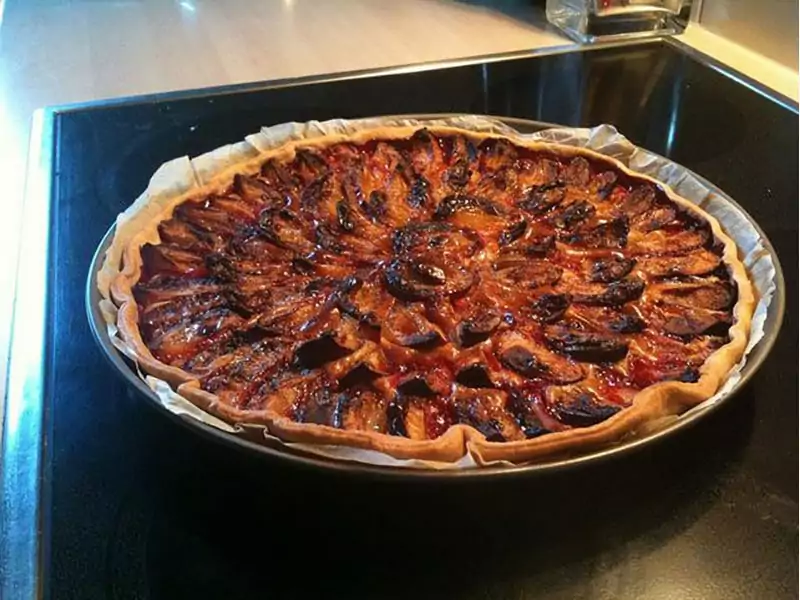
Quetschentaart, a fruit tart, is considered a traditional dessert in Luxembourg. This tart is straightforward to prepare at home and is typically baked in a round dish at 355°F to 390°F.
It features a buttery shortcrust base made from a mixture of butter, flour, and sugar. The fruit component consists of pitted and halved damsons, a fruit similar to plums but with a deep purple-black color.
This tart is particularly well-suited for autumn when you can easily find them in bakeries across the country. To enhance its flavor, serve it with a dollop of whipped cream.
58. Huesenziwwi (Marinated Hare)
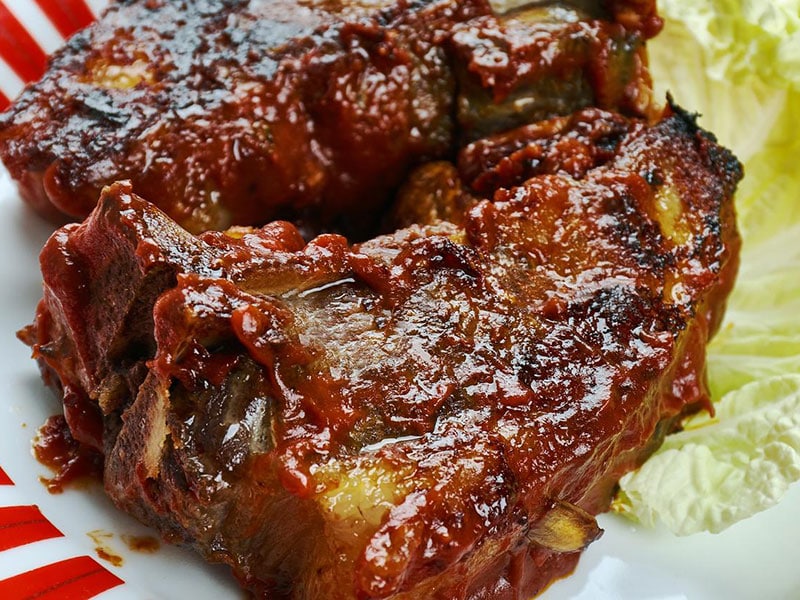
Marinated hare is an unusual yet delectable dish popular during the hunting season (October to December). The animal is similar to a rabbit but larger in size. It is marinated and cooked in a rich sauce made with hare blood, wine, pepper, and onions.
This dish requires a long cooking time of 48 to 72 hours to yield incredibly tender meat. To savor the most exquisite flavors, it is traditionally enjoyed with noodles or a glass of wine.
59. Friture de la Moselle (Deep-Fried Small Fish)
Friture de la Moselle puts fish at the forefront. The best ingredient is small fish seasoned with a mix of salt, pepper, and a splash of lemon juice. They are coated in a blend of flour and eggs. This preparation ensures that the deep-fried fish acquire a golden look and a crispy texture.
People typically serve this flavorful dish with lemon wedges on the plate and a glass of chilled wine on the side. If you ever get the chance, I highly recommend trying them at the renowned Koeppchen restaurant in Vermeldingen.
Other Cuisines
60. Barbajuan (Deep-Fried Chard-Filled Ravioli) – Monaco
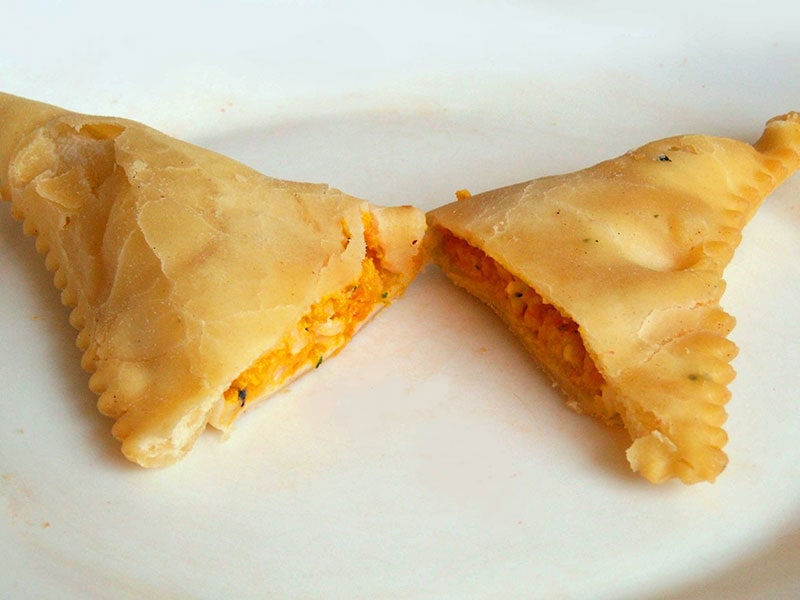
Barbajuan, meaning “Uncle John” in Monégasque, is a delicacy mainly found in Monaco and the eastern region of the French Riviera and western Liguria.
These bite-sized fritters are deep-fried and filled with a delicious combination of ricotta, Swiss chard, and other flavorful components. In Italy, they may even feature pumpkins, while the French version often includes ground meat and red squash.
Barbajuan is typically shaped into triangles. Locals commonly enjoy these delectable treats on Monaco’s national day, the 19th of November. They can be an appetizer, snack, or the main dish when paired with a fresh salad.
61. Stocafi (Seafood Stew) – Monaco
Stocafi is a traditional seafood stew in Monaco. This dish includes dried cod soaked in advance for approximately a day, then cooked with tomato sauce, olive oil, and a blend of aromatic spices like bay leaves and black pepper.
Finally, the stew is topped with black olives. For a perfect combination, don’t forget to serve it with boiled potatoes.
62. Oliebollen (Dutch Doughnuts) – Belgium And The Netherlands

Oliebollen (“oil balls”) are a beloved treat and street food in Belgium and the Netherlands. They are commonly enjoyed during New Year’s Eve celebrations and fairs. The dough is made with ingredients like flour, eggs, baking powder, sugar, milk, and salt.
Some variations include the addition of raisins, currants, or candied fruit. After the dough is prepared, it is deep-fried in hot oil. Once golden brown, Oliebollen are traditionally dusted with powdered sugar on top.
63. Potato Pancakes
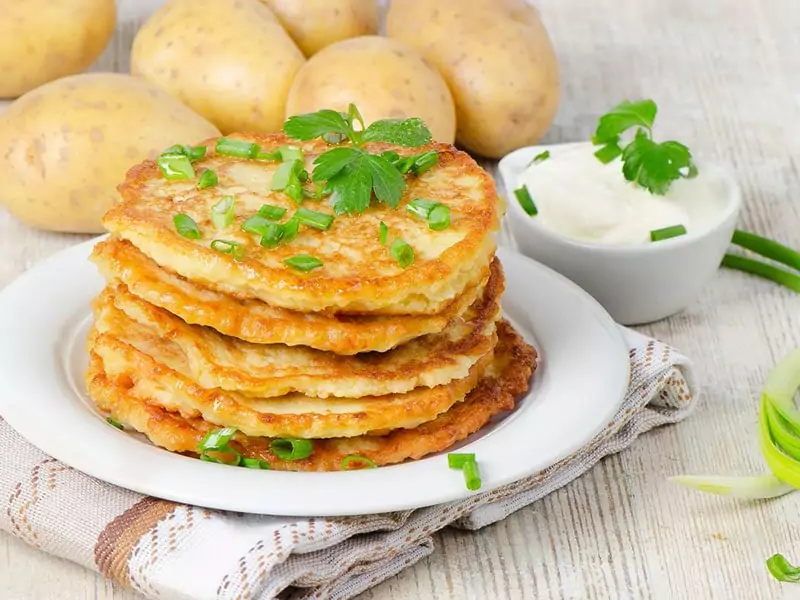
Potato pancakes come in many variations in different countries. In France, Pommes Darphin is a thick potato pancake, often paired with roasted meats.
On the other hand, Irish potato pancakes, known as Boxty, are shaped into smaller patties. They are fried in oil and offer a crispy texture. Likewise, Luxembourg’s version, Gromperekichelcher, is a deep-fried treat. It is commonly found at fairs or festivals throughout the country.
Impact And Influence of Western European Cuisine Globally
Influence on Other Cuisines
Western European cuisine has significantly influenced mainstream European desserts, appetizers, entrees, street foods, and more. French cooking techniques and sauces, for instance, have become fundamentals of modern culinary arts. Italian cuisine, with its pizza and pasta, has been globally adopted, adapted, and loved.
Fusion Cuisine Trends
Fusion cuisine often includes elements of Western European dishes. For example, the fusion of French and Asian cuisine has led to interesting blends of flavors and techniques.
Global Recognition of Western European Dishes
Western European dishes have received substantial recognition in the global culinary scene. This is evidenced by numerous Michelin-starred restaurants in this region. French and Italian cuisines are particularly well-represented.
The Role of Traditional Western European Dishes in Culture and Celebrations
Food as a Cultural Identity
Food plays an integral part in cultural identity in Western Europe. Dishes like Italy’s pasta, Spain’s paella, and England’s roast beef are synonymous with their respective nations. They are often a symbol of national pride and tradition.
Dishes Associated with Specific Celebrations or Traditions
Many time-honored European recipes are particularly associated with celebrations or traditions. For example, Christmas in Germany isn’t complete without Stollen, while Galette des Rois is eaten to celebrate Epiphany in France.
FAQs
Embrace The Timeless Charms Of Western European Dishes
Exploring the world of traditional Western European dishes has been nothing short of a thrilling voyage. I hope you’ve enjoyed discovering the charm and flavors of this varied and historical cuisine as much as I have.
If these meals have captured your heart just like mine, don’t hold back. Give that like button a tap, drop a comment with your thoughts, and share the love for these gastronomic gems with your friends. Let’s keep the spirit of Western European cuisine alive!
References
- Macau, M.G.D.-H.K. (2018) The 5 mother sauces of French cuisine, MICHELIN Guide.
- Are snails good for you? Pros and cons, nutrition information, and more (no date) WebMD.
- What are the risks of eating steak tartare? (2017) Office for Science and Society.
- Bilton, S. (2023) Deconstructing Christmas pudding: Secrets of a seasonal staple, Travel.
- Kubala, J. (2022) 9 impressive health benefits of cabbage, Healthline.


